September 9, 2022
by Indie Gamer Chick
Well, everyone liked the Capcom Arcade 2nd Stadium review, and the “definitive review” format has been getting praised. At long last, I finally got the retro collection review style correct. I’ve tried a few styles, but this one seems to be catching on. And what do you know? The perfect collection to test the format out just released.
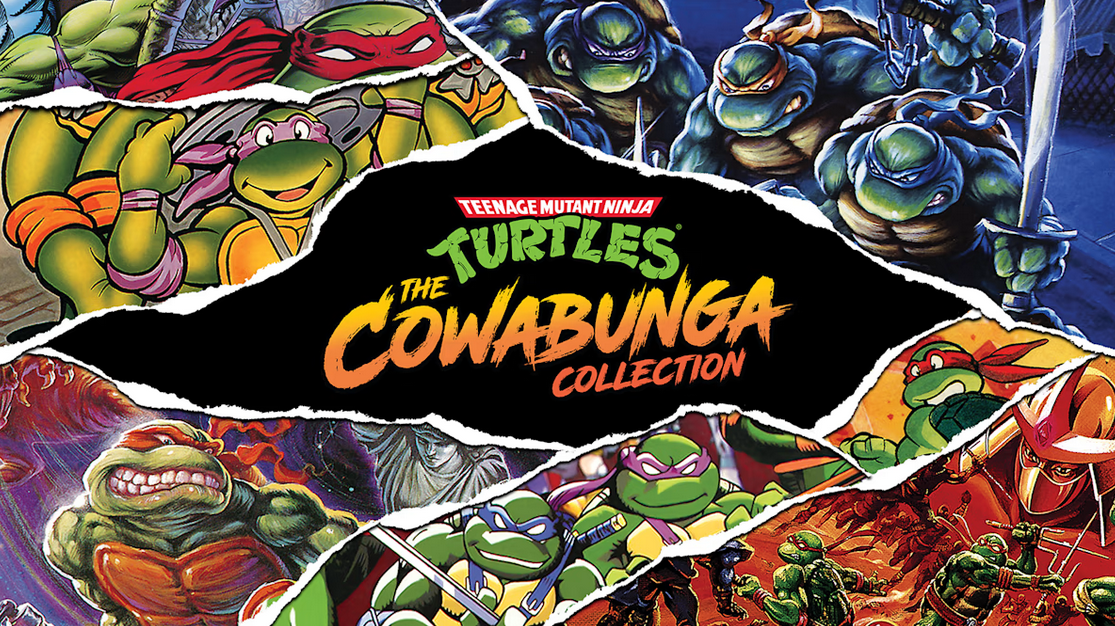
Teenage Mutant Ninja Turtles: The Cowabunga Collection is a set of thirteen games released between 1989 and 1993. Well, actually, it’s nine different games. You get both the 1989 Konami coin-op Teenage Mutant Ninja Turtles and the NES conversion Teenage Mutant Ninja Turtles II: The Arcade Game. Turtles in Time includes both the SNES and Coin-Op versions, and then there’s THREE versions of Teenage Mutant Ninja Turtles: Tournament Fighters (NES, SNES, and Genesis). So, nine “base” games with four variations are part of this set, right? Actually, it’s even more complicated than that. Hyperstone Heist for the Sega Genesis is really more of a shortened remix of the two arcade games that eliminates the most satisfying attack (throwing the enemies at the screen) from Turtles in Time. And the three Tournament Fighters games are all made by different development teams and aren’t merely variations of one game. While the base concept, a Street Fighter type of game with Ninja Turtles characters remains the same, each of the three games were made by different teams at Konami. They use different engines. They have different rosters. It’s three completely different games that merit their own separate review. Thus, there’s really only two games that are truly variations of the same exact game, and that’s Turtles II for the NES and Turtles IV for the SNES. Like I said, this is a great game to test the Definitive Review format.
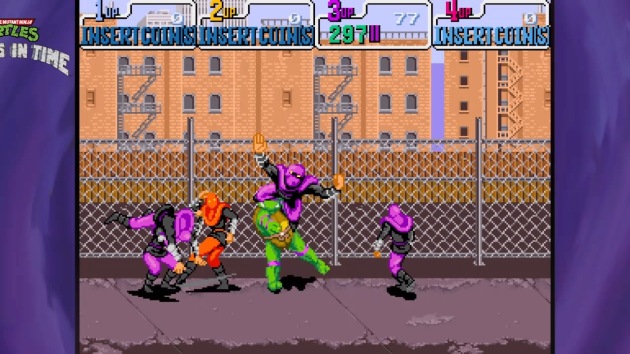
Look, Ma! No hands!
The set retails for $39.99. I feel that $4.99 is a fair price for a good retro game from this set, so the target is to score eight YES! verdicts, right? Well, not so fast. Unlike Capcom Arcade 2nd Stadium, The Cowabunga Collection features a wealth of bonus material. I don’t mean like instructions on how to play the games or a couple common emulation features. In my opinion, retro sets have no excuse to not have detailed instructions on how to play the games along with the ability to use save states or rewind. But, Cowabunga Collection goes above and beyond what you’d expect in this type of retro game collection, and thus, I have to put a value on the extras.
EMULATION EXTRAS
Cowabunga Collection features save states and rewind, which are such must-haves that I’m just as likely to penalize a retro collection these days for not including them. That alone would have been enough to satisfy me, even if you can only rewind 30 seconds of gameplay. In my opinion, a minute or longer is optimal. But, they did what they needed to do, and that should have been enough. But the masters of retro gaming, Digital Eclipse, took it a step further with the greatest feature in the history of emulation. Those who remember me drooling over SNK 40th Anniversary Collection’s “watch a full gameplay video that you can stop at any time and join the game at that exact moment” will be happy to hear that feature returns for Cowabunga Collection. I know that it’s actually not that big a deal because of how emulation works, but it’s not as common a feature as I wish it was. To me, it’s practically witchcraft.
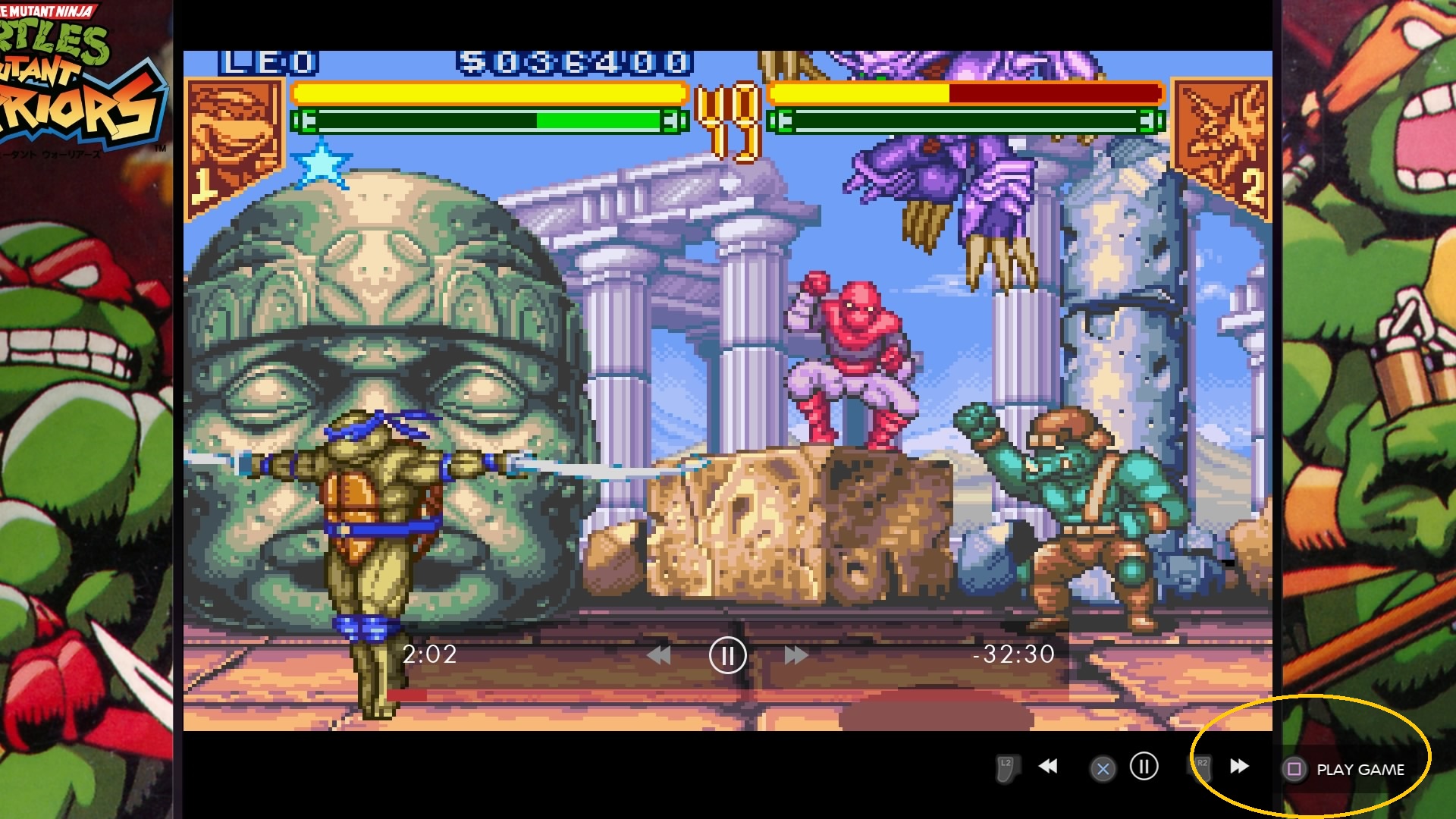
Watch the video, which is a perfect no-hit run no matter which game you play. Hit the PLAY GAME button at any time and you take control from there. It’s awesome. I love it.
It came in handy when I played the 1989 NES Teenage Mutant Ninja Turtles and went to upload media right before I started the infamous underwater sequence. After I finished uploading, I was horrified to see that the game didn’t pause from me using the system guide button. Seriously, I was actually close to penalizing the set for that. Dear game makers: whenever the guide button on any console is hit, pausing the game should be a gimmie. Anyway, I put myself in a position where there wasn’t enough time left for me to beat the stage. But, I was able to use the video to return to that exact spot, like nothing happened. Actually, I was in better shape because the video is a perfect run of the game, with no damage taken. All thirteen games include the video play-through with jump-in ability, and that alone is worthy of a bonus, but we’re just getting started.
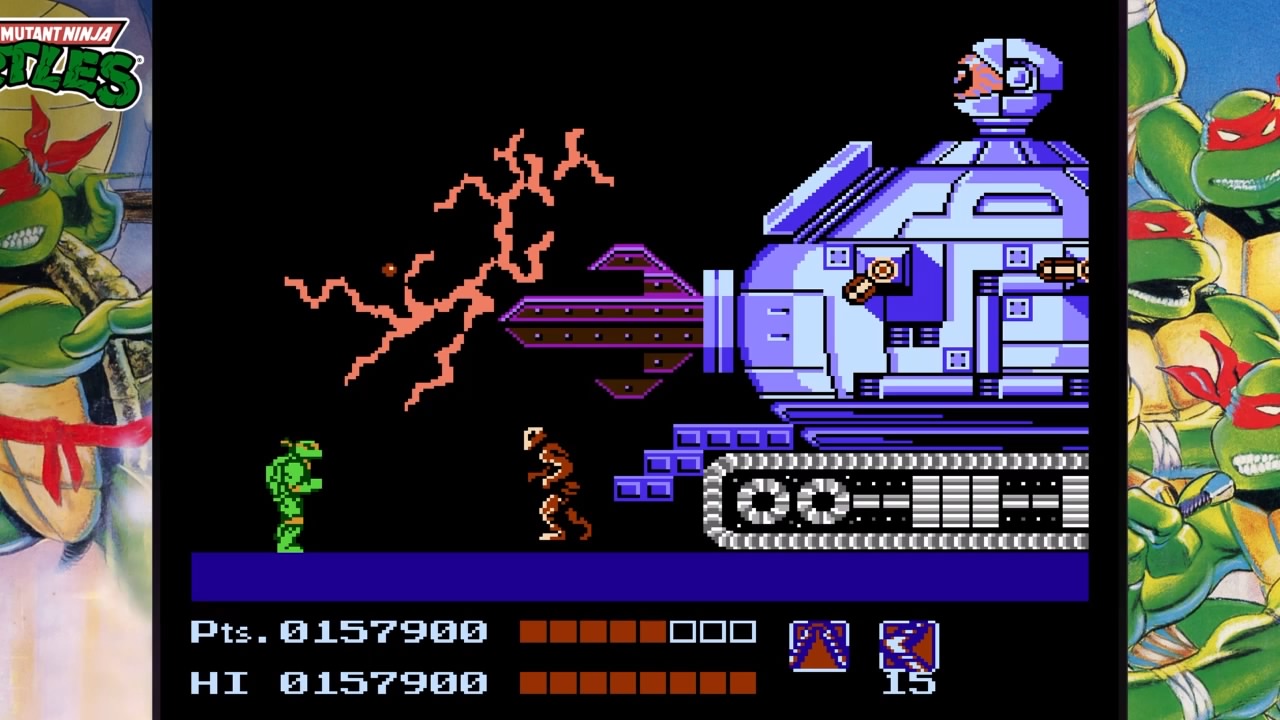
While the removal of flicker and slowdown doesn’t save the NES version of Teenage Mutant Ninja Turtles from the NO! pile, I’ll note that I played the Technodrome battle with the slowdown/flicker turned on and it was unplayable. I’m VERY happy Digital Eclipse did the right thing and gave people the ability to turn them off. Hell, in my opinion, THAT should have been the default setting and turning them back on should have been the thing that was optional.
In addition to having both the Japanese and US ROMs, all thirteen games have optional “enhancements” of various quality. They’re usually based around cheat codes that required button inputs, and how useful they are isn’t consistent. The NES TMNT offers flicker reduction and slowdown reduction. Neither are 100% perfect, but playing with them turned off, you can easily notice the difference. Turtles 1 is a game that spams the screen with enemies, and bosses like the Technodrome basically have slowdown going non-stop, which also makes the controls less responsive. You can eliminate those issues now in the first TMNT plus the other two NES games. Turtles 2 and 3 on the NES offer other options too, like extra or infinite lives and easier menu navigation. The arcade games offer both “God Mode” (invincibility and one-hit kills) and “Nightmare Mode” (lots more enemies). Turning both God Mode and Nightmare mode on DO make for quite the satisfying brawling experience. The Game Boy games are the least consistent. The first one offers only the ability to practice the bonus game. The second gives you the option for infinite lives and to change which level you start on. The third one offers you only the ability to turn-on a better map. Sure, I wish they had really amazing options for every game, but there’s something helpful that improves the overall quality of every game at least a little bit. Oh, and there’s online play for the two arcade games, Hyperstone Heist on the Genesis, and the SNES version of Tournament Fighters. For all the added emulation extras, I’m crediting $10 to Cowabunga Collection.
EXTRA MEDIA FEATURES
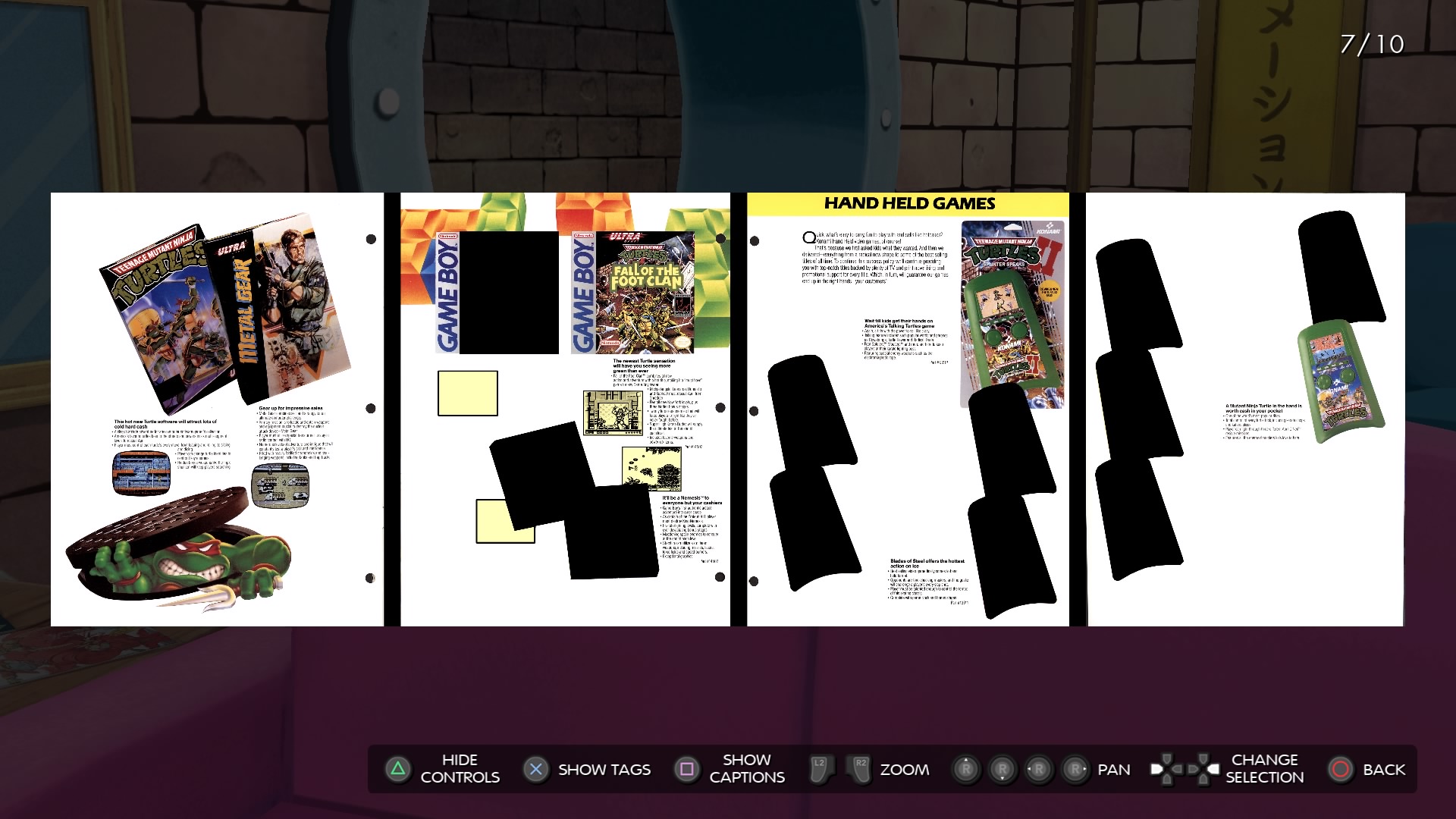
Any licensed game that’s not TMNT-related that appeared alongside a Ninja Turtles game in advertisements is treated like it’s in the witness protection program. Oh and since the LCD games are shown here, WHY DIDN’T WE GET THOSE AS A SUPER DUPER SPECIAL THROWN-IN BONUS? Would have been nice. I did a seven part LCD review series, 100+ games, but apparently nobody emulated the TMNT ones.
There’s a lot of extras in Cowabunga Collection. Hell, there’s so many that Digital Eclipse included the ability to search them in the menu. Dang. There’s boxes and manuals for all the home games from North America and Japan. Regardless of what console you’re on, you’ll see the Nintendo branding and seal of quality in all its glory, along with Sega’s branding on the Genesis game. They even have the arcade schematics too. There’s tons of ads from magazines and catalogs. Those can be weird, because if a Ninja Turtles game shared the space with another game from another IP, the other IP’s game is removed by blacking it out. Also included is every single cover for six different eras of Ninja Turtles comic books and still shots from four different Ninja Turtles TV shows (no Power Rangers crossover, sadly). There’s complete soundtracks and strategy guides for the games, and I actually did use it to help me finish the first NES game. There’s behind-the-scenes documents, and this is where the really good stuff is. Included in this section is stuff the IP’s “style guide” which is what IP holders send to licensees to show them how the characters MUST be drawn. Finally, there’s design documents for seven of the home games that show you concept art, portraits, sprites, storyboards, etc. If you can’t read Japanese, you’ll need to turn on the captions, and I’m not sure why translations weren’t set as a default but I’m happy they’re there. I spent over an hour sorting through the extras and never got bored. For all the media extra features, I’m crediting $10 to Cowabunga Collection.
THE ULTIMATE VERDICT ON THE COLLECTION
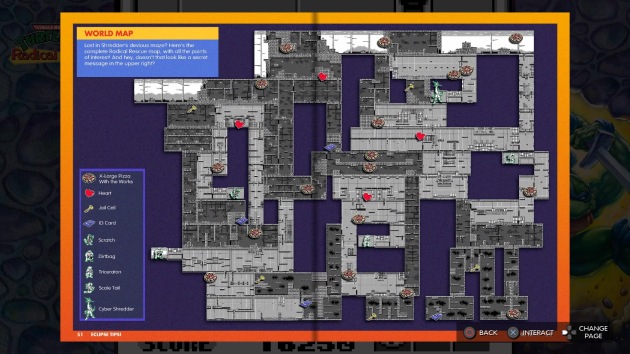
Really, only three of the games NEED the built-in strategy guide: Teenage Mutant Ninja Turtles (NES), Radical Rescue (Game Boy, map shown in pic) and the SNES Tournament Fighters (to learn the special moves). But, I’m happy the maps were there. They really went all-out on this set.
Even though I’ve played most of the games in this set before, and in some cases, had already given my complete thoughts on them, I gave all thirteen games a fully clean slate. Only the Cowabunga Collection version of the included games counts for this feature. For those not familiar with my way of thinking of how retro games should be reviewed, I take NO historical context into account. I don’t care how important a game was to the industry, because that doesn’t make a game worth playing today. The test of time is the cruelest test of all, but every video game must face it. I might not be here if not for Space Invaders’ success, but I wouldn’t want to play it today. Not when there’s better options. Therefore, when I review retro games, every game gets either a YES! or a NO!
YES! means the game is still fun and has actual gameplay value when played today and is worth seeking out.
NO! means the game didn’t age gracefully and is not worth seeking out, and certainly not worth spending money on.
With $20 in credit earned and the value of a good retro Ninja Turtles game fixed at $4.99, Teenage Mutant Ninja Turtles: The Cowabunga Collection needs to score four YES! votes to win my seal of approval.
YES!: 5
NO!: 8
 Teenage Mutant Ninja Turtles: The Cowabunga Collection is Chick-Approved. Having an official re-release of Turtles in Time for the SNES is a pretty amazing thing, but this collection has a few surprises as well. I didn’t expect to like the original arcade game, and in fact, I enjoyed my time with it a lot. I didn’t expect to like any of the Game Boy games, but two of them were acceptable time wasters. I certainly didn’t expect to enjoy the two hours I spent with Manhattan Project for the NES, yet here we are. Five totally solid Turtles games, emulated to perfection, plus a whole lot of bonus material, makes this a set worthy of purchase.
Teenage Mutant Ninja Turtles: The Cowabunga Collection is Chick-Approved. Having an official re-release of Turtles in Time for the SNES is a pretty amazing thing, but this collection has a few surprises as well. I didn’t expect to like the original arcade game, and in fact, I enjoyed my time with it a lot. I didn’t expect to like any of the Game Boy games, but two of them were acceptable time wasters. I certainly didn’t expect to enjoy the two hours I spent with Manhattan Project for the NES, yet here we are. Five totally solid Turtles games, emulated to perfection, plus a whole lot of bonus material, makes this a set worthy of purchase.
FINAL RANKINGS
How I determined the rankings is simple: I took the full list of games, then I said “I’m forced to play one game. Pick the one I could play the most and not get bored with.” That goes on top of the list. Then I repeat the question again with the remaining games over and over until the list is complete. Based on that simple criteria, here are the final rankings. Games above the Terminator Line received a YES! Games below it received a NO!
- Teenage Mutant Ninja Turtles IV: Turtles in Time (SNES)
- Teenage Mutant Ninja Turtles III: The Manhattan Project (NES)
- Teenage Mutant Ninja Turtles (Arcade)
- Teenage Mutant Ninja Turtles III: Radical Rescue (Game Boy)
- Teenage Mutant Ninja Turtles: Fall of the Foot Clan (Game Boy)
**TERMINATOR LINE**
- Teenage Mutant Ninja Turtles: Tournament Fighters (SNES)
- Teenage Mutant Ninja Turtles II: The Arcade Game (NES)
- Teenage Mutant Ninja Turtles: Turtles in Time (Arcade)
- Teenage Mutant Ninja Turtles: The Hyperstone Heist (Genesis)
- Teenage Mutant Ninja Turtles (NES)
- Teenage Mutant Ninja Turtles: Tournament Fighters (NES)
- Teenage Mutant Ninja Turtles II: Back from the Sewers (Game Boy)
- Teenage Mutant Ninja Turtles: Tournament Fighters (Genesis)
GAME REVIEWS
Teenage Mutant Ninja Turtles
for Nintendo Entertainment System
Released June 25, 1989

One of my major annoyances with TMNT-NES is how enemies spawn. In this screen, you can see the playfield is spammed with enemies to such a degree that there’s basically no way you won’t take damage. Enemies respawn if you walk off the screen too, which is common on the NES, but TMNT-NES is really weird about how scrolling works, so backing up to have room to fight might scroll the screen more and cause the enemy to respawn before you’ve even killed the original.
By far the most interesting game in Cowabunga Collection is the very first Ninja Turtles game. Don’t mistake that for being “good.” It’s not. TMNT-NES is a complete disaster. But, it’s a compelling disaster. I’ll give it that. Basically, everything that can go wrong does go wrong here. The most important thing is that it feels nothing at all like a Ninja Turtles game. Even with the Turtles and their signature weapons. Even with Bebop, Rocksteady, the Technodrome, and Shredder. I first played Ninja Turtles a couple years ago when I ran through almost the entire NES library, and I walked away with a niggling suspicion that this started development as a completely different game that was converted into TMNT as soon as Konami got the license so they could strike while the IP was red-hot. Apparently, it’s not true. There was no asset flipping or sprites from unused games. They just rushed this through and came up with enemies as fast as possible on the assumption that the Ninja Turtles fad could burn out at any moment. The hurried development shows. The complete lack of polish and unrelenting swarms of enemies that would normally make the NES chug like a freshman at homecoming are things that should never have made it to the final product. The Cowabunga Collection version of TMNT can muffle the slowdown and non-stop flicker (there IS still a bit of both, but nowhere near as noticeable now) but that only makes the terrible design choices of TMNT stand out more.
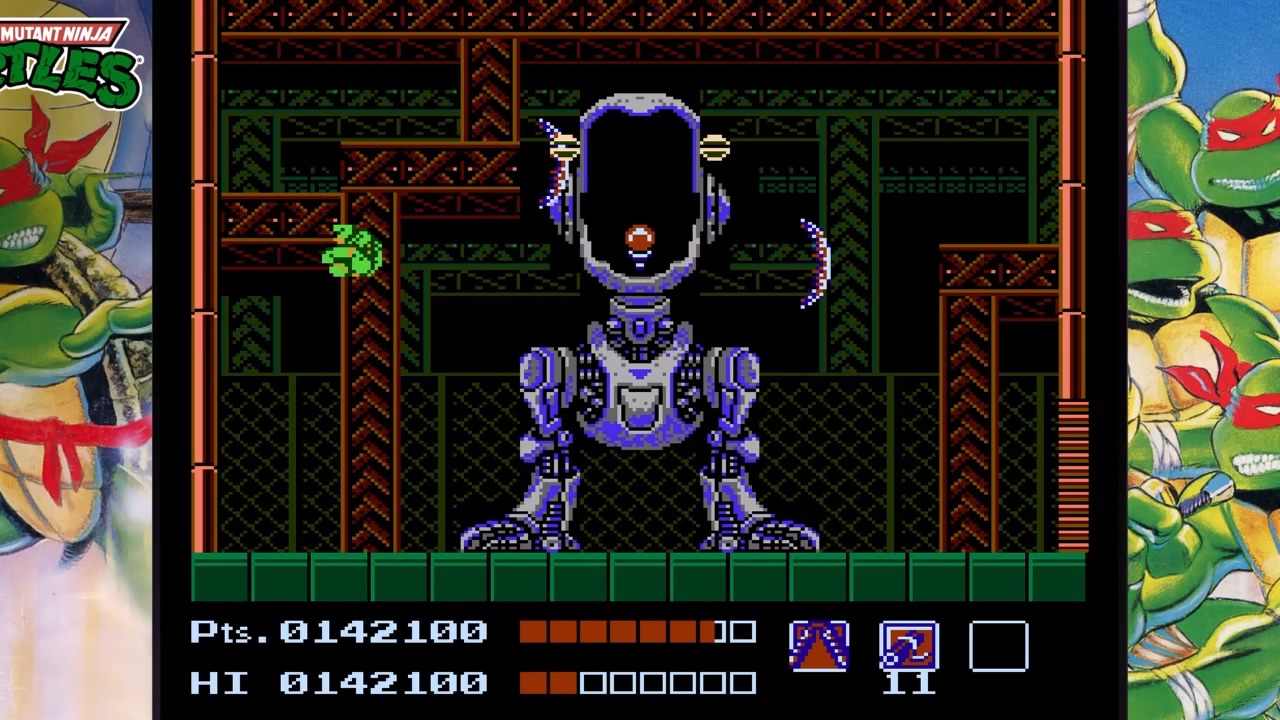
The Giant Mouser and the Technodrome are the only two boss fights that feel “epic.” The rest feel like fights against normal enemies. If anything, the Mouser fight feels like it’s straight out of Contra.
What annoys me most about TMNT-NES is that there’s a great game buried within this dumpster fire. Not MISSING from the game, but already in the game. Well, actually, this could have used a lot better level design in general, but the basic concept of how the levels work is very solid. I like the idea of traversing an overworld and searching sewers and buildings for the correct pathway to the end of each stage. New York City is maze-like, after all, so why not take advantage of that? I like that part. It’s the only good idea the game had, and even then they bungled it by having too many dead-ends and “red herring” buildings. Sure, there’s pizzas or items in them, but the way enemies respawn often isn’t designed with moving forward and backwards through the levels in mind. Often, you’re better off just running for it and not engaging the enemies at all. If not for the abysmal collision detection.. which is seriously among the worst in the history of video games.. the combat would be pretty satisfying. At least when you use Donatello. His staff is slow but has the most reach and causes the most damage. That’s right: getting poked with a large wooden stick is more lethal in the world of Ninja Turtles than being stabbed or sliced with sharp, pointy metal. If you think of this as Donatello: The Video Game, it works a lot better. With practice, you can even use his unique striking style to damage enemies behind you. Donatello is the man, and I only used the other Turtles if I had acquired a subweapon using them or if I didn’t want to take damage with Donatello. Hell, unless you have the other three Turtles loaded down with sub-weapons, the second-to-last boss, the Technodrome, is pretty much impossible to beat without him. You can’t disable the electric fork in the front with anyone else’s weapon. They don’t have enough range. What was Konami thinking when they green-lit this?
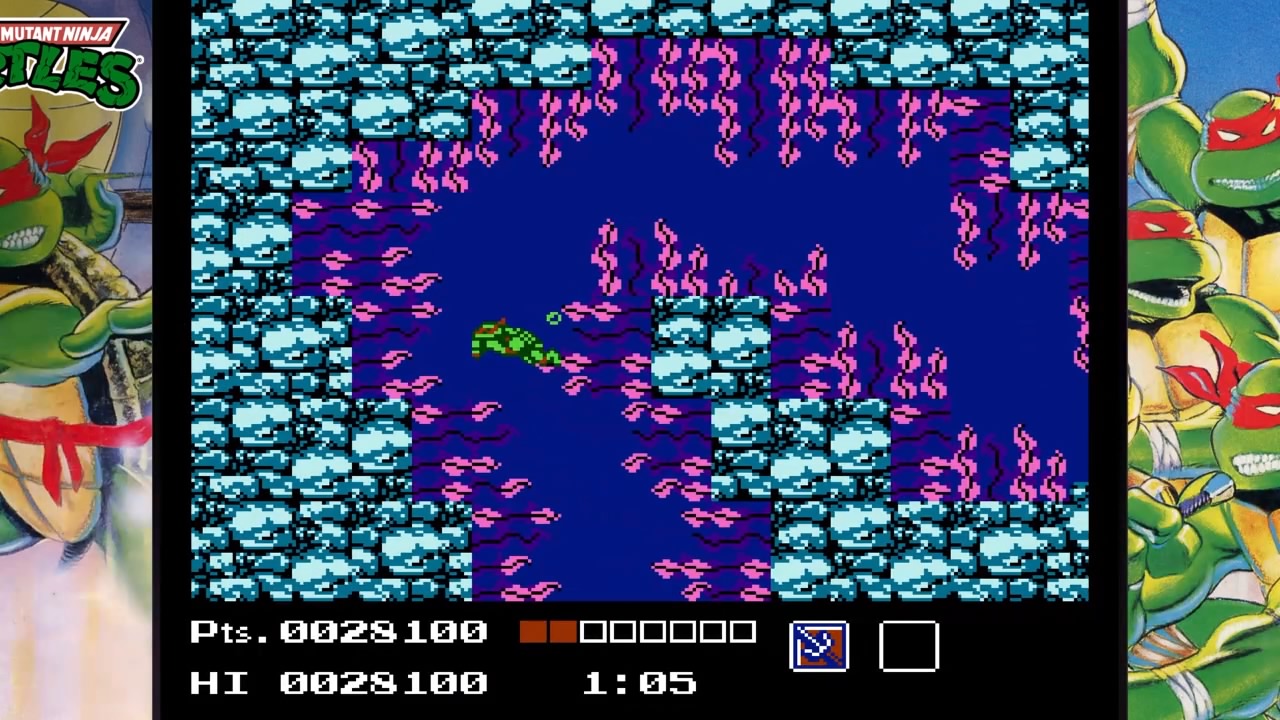
Oh you bastard. You bastard. There’s nothing I can say that others haven’t already said about the infamous underwater sequence. It’s every bit as bad as its reputation suggests. For my money, it’s the worst level in the history of video games. Not even the Speed Bike stage on Battletoads is this bad, because at least there the controls and collision aren’t awful. When you finish this review, go watch this video that explains how the awful collision ruins this stage. It’s truly jaw-dropping how badly coded this game is. You didn’t expect that from Konami games of this era. They were only months away from releasing Castlevania III in Japan when this came out, a contender for the best game on the NES.
For a set that’s loaded with extras, I’m a little more than ticked off that it was never explained anywhere in the game (the original instruction manual or Cowabunga Collection’s built-in strategy guide) that each turtle actually has unique special attributes. Leonardo does the least damage, unless his health falls below four bars, at which point it doubles. Because that’s how swords would work, or something. Raphael has the fastest weapons in the game but can’t do a down-thrust. Michelangelo can’t attack downward either and he has poor range, but like Leonardo, his attack power doubles when he’s under four bars of health. I feel like this is one of the great missed opportunities of the NES era. This isn’t a side-scrolling beat-em-up. It’s a full-fledged platforming adventure with labyrinthine levels. Assigning more unique abilities to each Turtle could have made for a more strategic, enticing game. But that’s not what Konami did. There’s really never a point when you’ll want to use a Turtle besides Donny, and that’s especially damning. Honestly, it feels like everything was put into making level one good, so that kids would rent it and pester their parents to buy it. Pretty much the whole game from level two onward becomes so unfair that I actively wonder why Ghosts ‘n Goblins became the poster child for mean-spirited game design when TMNT outsold it 3 to 1 and is nearly as unfair. For all the crap the dam level gets, that final stretch before you get to Shredder is straight-up bullshit. Then again, most TMNT owners never made it past level three from what I can gather, and 99.9% certainly never made it past the Technodrome.
This slideshow requires JavaScript.
After level one, there’s just nothing really enjoyable left to do because TMNT-NES loses all semblance of balance. The enemies can be spongy, cheap, and too quick to respawn. Most of them have literally nothing to do with the Teenage Mutant Ninja Turtles franchise and feel like they’re unused character sprites from horror games or sci-fi games. Not badly designed or ugly character models, but I can’t imagine a child in 1989 understood at all why their TMNT game felt almost nothing like the show or movie or comic they fell in love with. I’m not even a Turtles fan myself, as it had already kind of dried out by time I was the right age for it, and even I’m like “what the hell are all these monsters from?” The answer is not from THE Ninja Turtles franchise. Hell, the Giant Mouser feels like a Contra boss. Speaking of bosses: after a couple hours worth of cheap enemy placement, swarming bosses, and unavoidable damage, I entered the final room with Shredder and beat him without cheating in ten seconds without taking a single hit of damage. If there had been someone in the room with me who had a trumpet, they would have played WOMP WOMP at that moment. Despite all the problems I have with Ninja Turtles, I feel like there really is a potentially great game here. While it never feels like a TMNT game, it always feels distinctly NES Konami-like. If you altered some jumps, tightened the collision detection, eliminated the time limit and changed how swimming works in the underwater area, adjusted the respawning, and gave the empty buildings an actual purpose besides being a wild goose chase for players, TMNT could have been one of THE greats on NES. Of course, what I just said is basically “if you change the whole game, it could have been a masterpiece!” By the way, this was the best-selling 3rd Party NES game of all-time. Go figure, right?
Verdict: NO!
Cowabunga Collection Ranking: #10 of 13
Teenage Mutant Ninja Turtles
for Arcades
Released October 11, 1989
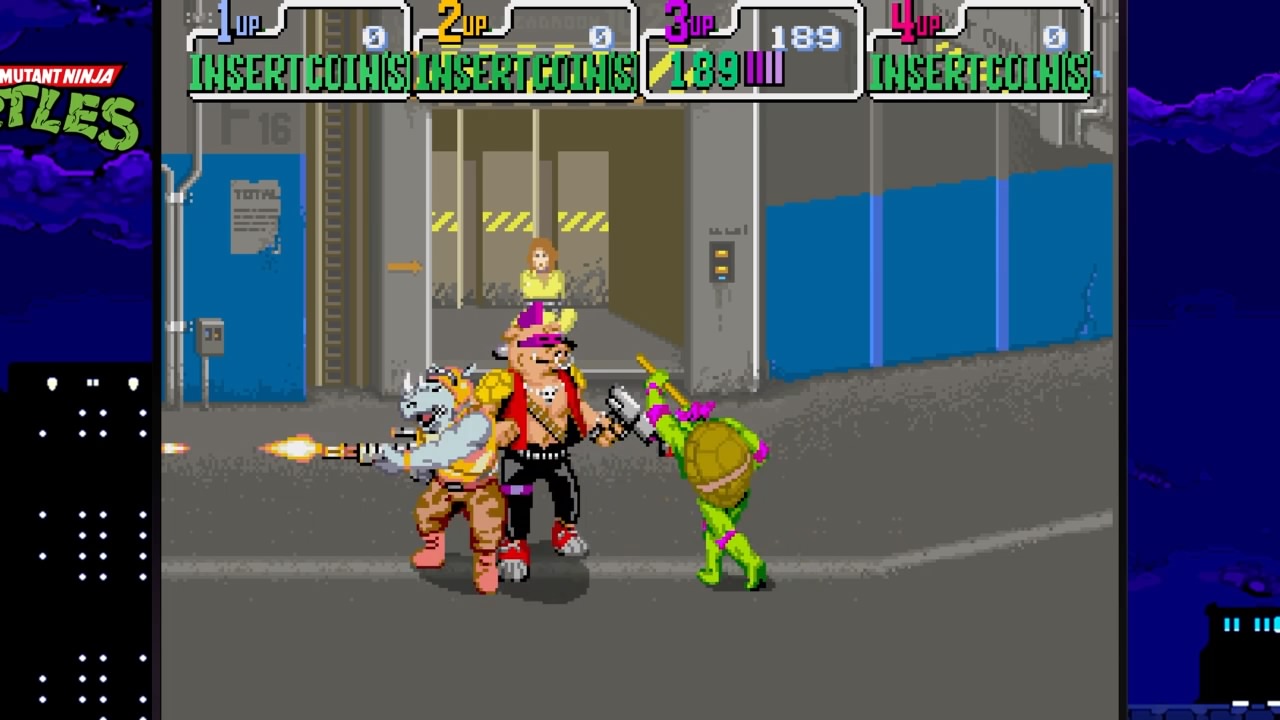
This came out exactly two months after I was born. There’s actually no value to that useless fact, but I figured I would share it.
Being a weirdo, I played the NES port before playing the arcade game. I’m famously not a fan of the Simpsons arcade game, and I thought I wasn’t of the TMNT arcade game. It makes sense, right? Same development team. Same engine. Same sense that the game was rushed to the market to strike while the iron was hot. Now, I’m racking my brain trying to figure out if I ever played the arcade game before. I’m not entirely sure I have, because I had a pretty good time with it. In stark contrast to the slow, plodding, extremely stripped-down NES game that somehow earned a reputation as a really good port, I actually really enjoyed my time playing Teenage Mutant Ninja Turtles: The Arcade Game. A big part of that is that it breezes right on by at an astonishingly fast pace. Compared with the NES port, where after about twenty minutes, I felt like I was going to burst into tears every time I realized I wasn’t on the last level.
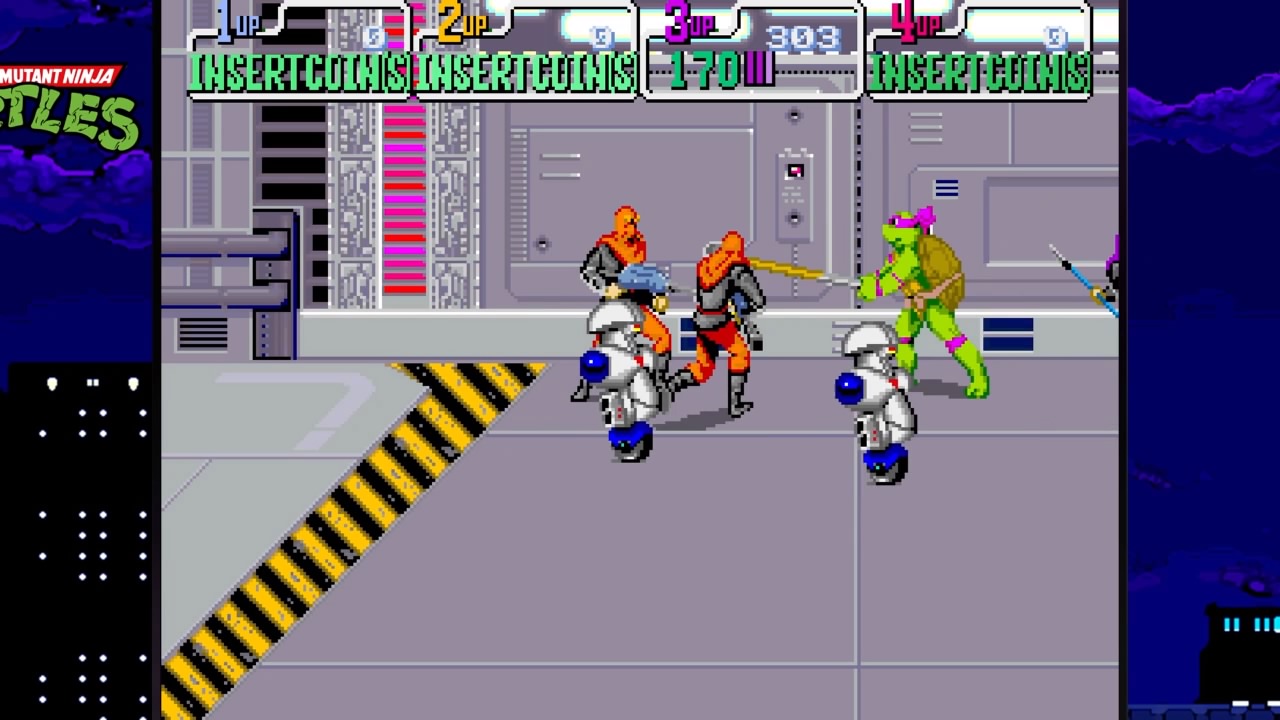
Yea yea, you’re supposed to play this multiplayer. Well, my family enjoyed doing the recent indie Shredder’s Revenge with me (yes, it’s an indie) getting them to play retro games is like pulling teeth.
The arcade game has only two major flaws. The first is that the handful of flying enemies feel like they have inaccurate collision boxes compared to the plane of existence you stand on. Lining yourself up to damage them is extremely frustrating. The fight with Baxter Stockman is particularly annoying, and after throwing drop kicks from every angle and hitting around one out of six times, the game gave me a mercy ruling and he just flew away. Wow. Thankfully, the issue with flyers isn’t a deal breaker. The bigger problem with TMNT Arcade is there’s very limited OOMPH! to the fight. Your attacks feel kind of weightless, and that drops this out of the realm of “best brawlers” because you need that sense of violence for immersion. So, it’s remarkable that I still had a good time.
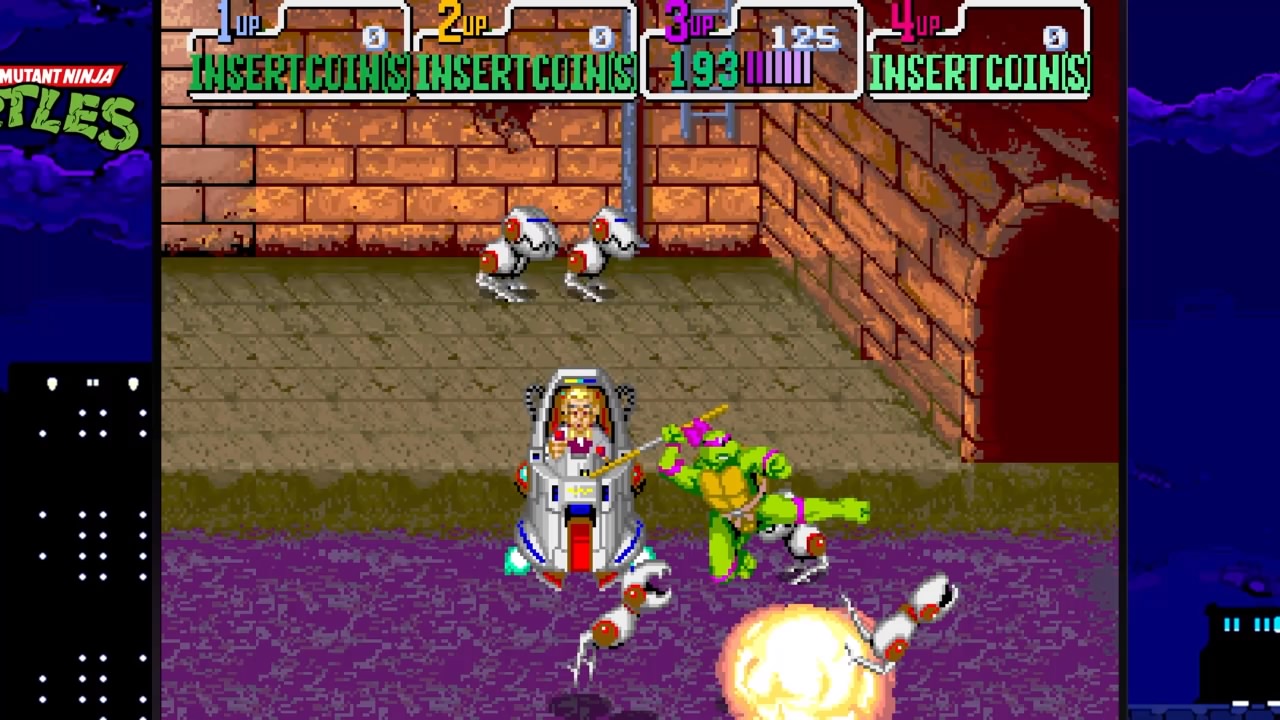
The only truly putrid element of TMNT Arcade is the Baxter Stockman fight. It’s not just lining up to score a hit that’s a pain in the ass. He drops too many mousers, which require you to button mash to escape. It’s a terrible arena for the battle too. I hated everything about this fight. The only thing the NES port did better was this part.
But, I never got bored with the gameplay. Konami stretched a lot satisfying combat out of two button gameplay. Satisfying enough, in fact, that I opted not to simply spam the special attack that kills foot soldiers in one hit. This is before those type of attacks came at the price of a sliver of health, but I enjoyed using my basic attacks, and often did. That’s something that’s completely gone from the NES game. The moments where the bad guys attack from every angle don’t even frustrate, because it feels true to the spirit of the property. As far as licensed games from this era go, the original arcade TMNT has to be among the best at making the game feel like the IP. The bosses, especially early ones, aren’t the total sponges. TMNT Arcade’s bosses are basically the prototype for the “Konami Style Brawler Boss” that I adore. The last couple do get borderline spongy, but it feels climatic. Shredder’s one-hit instakill felt a bit “quick! Wring every last quarter out of the little bastards” cynical, but otherwise, I had a lot of fun with the 1989 TMNT arcade game, and I didn’t expect to at all.
Verdict: YES!
Cowabunga Collection Ranking: #3 of 13
Teenage Mutant Ninja Turtles II: The Arcade Game
for the Nintendo Entertainment System
Released December 14, 1990

The Shredder fight is especially tedious. He clones himself, and you can only tell which is the real one by knocking his helmet off. At this point, the fake one usually hangs out close by the real one so that you accidently kill it, at which point another spawns. Oh and the instakill death ray is bullshit. At least here, it’s doesn’t feel like it’s trying to squeeze as many last-second quarters out of players as possible, I guess. Oh, and play the JP version if you insist on playing this, where the dropkick causes as much damage as the special attack, and the SP attack is easier to do.
Calling the NES port of the arcade Ninja Turtles “boring” is sacrilege to an entire generation that came before me, but I’ll proudly wear the blasphemer tag before I say anything nice about Teenage Mutant Ninja Turtles II: The Arcade Game. It’s boring. Like, really boring. This is NOT a good port of the arcade game. I was stunned when I played the arcade game after playing this and saw how many more moves just hitting the attack button could do. In addition to the normal attack, Donatello could lift enemies up over his head and throw them, a fairly satisfying move. That’s gone here. In fact, I didn’t want to use basic attacks at all because the enemies tended to counter attack them too quickly. That left only two other options: the lone type of drop kick you get (the arcade version gives multiple) and the power attack that kills all the foot soldiers in one hit. Levels take a lot longer to slog through, and to really add insult to injury, they added two more levels that have some fairly cheap GOTCHA! type of hits. They also changed the fight against both Bebop & Rocksteady to a fight against the fly version of Baxter. Okay, fine, there IS one positive thing I can say: it’s easier to kill flying enemies in this version, but that’s on account of some very generous collision with them. TMNT 2-NES has overall bad collision detection, spongier bosses, and levels so long they could be called eras. You kids from generations before were far too easy to impress, because they turned a fun, fast-paced romp into a slow, plodding, padded slog.
Verdict: NO!
Cowabunga Collection Ranking: #7 of 13
Teenage Mutant Ninja Turtles: Fall of the Foot Clan
for the Game Boy
Released August, 1990

I genuinely go into all these games with as open a mind as humanly possible. Having said that, I’m floored I gave a YES! to Fall of the Foot Clan. I figured the second and third Game Boy TMNT games had a shot, but that there was no way in hell a first-gen GB game that was likely rushed through development as fast as possible to cash-in on the Ninja Turtle craze before it stopped being profitable had any chance of being fun.
Fall of the Foot Clan is a pleasant surprise on the same level as when you put your pants on and find a dollar bill in one of the pockets that you didn’t know was there. It’s not exactly cause for celebration but it’ll put a smile on your face. This early Game Boy release is one of the stronger third party GB titles from that early period, easily out-classing Konami’s first attempt at a Castlevania for Game Boy. It’s not exactly the most ambitious title. In fact, it’s so generic that they could have made this any IP and it would have felt the same. The Turtles have no variation between them besides how their weapons look, at least from what I can tell, and it’s not like the Game Boy can show the different colored masks. The gameplay is as basic as it gets. You walk right and enemies jump onto the screen and you whack them with your weapon. Occasionally you have to jump, but mostly, you just walk right. There’s no power-ups besides life-restoring pizzas. There’s an awful lack of variety in both enemies and the way they attack. Fall of the Foot Clan’s gameplay is as shallow as a mud puddle. Honestly, the levels often feel like LCD type action games with better animation.
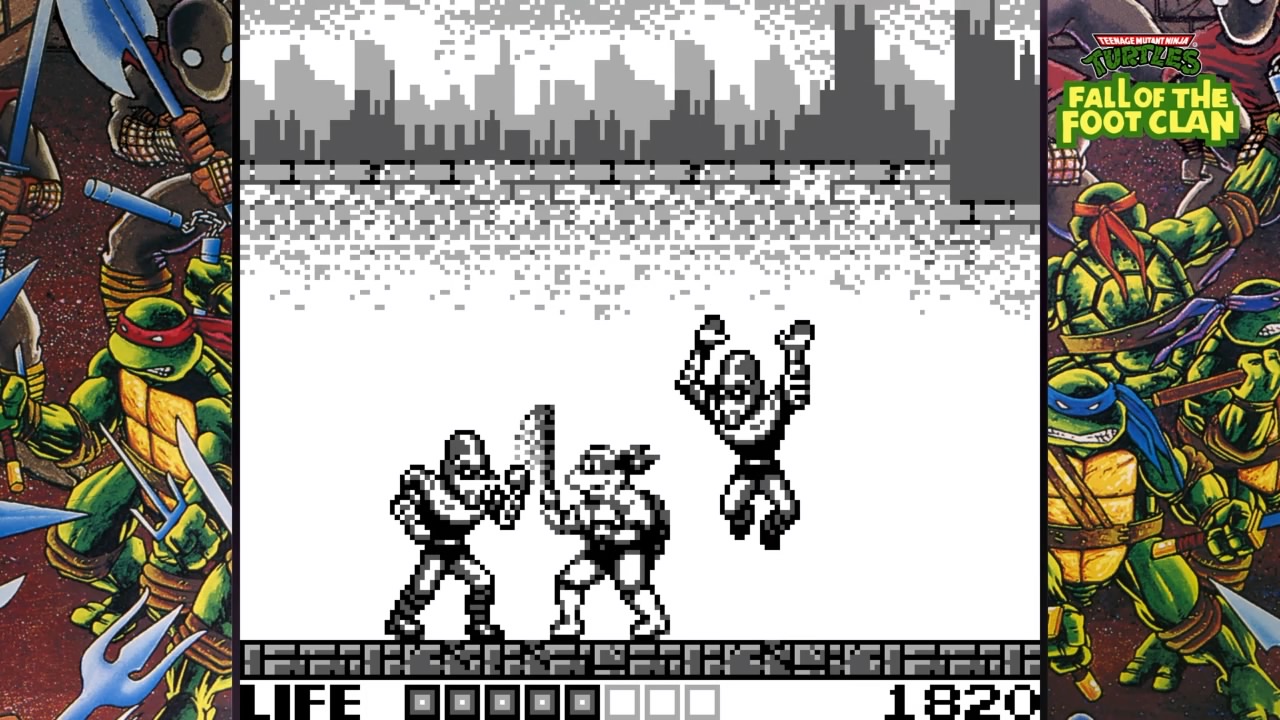
What gave me the LCD vibe is how the enemies tend to attack in the exact same way. Foot soldiers jump in from the left and the right, slightly out of sync, so that you can smack one, then turn around and smack the other. This attack pattern is repeated almost non-stop throughout the game. Little robot enemies will buzz across the top before lowering down so you can smack them. You’re moving right. You’re jumping over gaps. You’re changing levels. But, the same attack pattern with the same enemies repeats over and over. I’ve never seen a non-LCD action game that mimics the LCD spinning-plate-style like this before.
But, I never got bored with it! It helps that the action is pretty much non-stop, plus this became the first TMNT home game with accurate collision detection. Enemies drop pizza slices in regular intervals, and if you want a little variety, you have an unlimited supply of ninja stars to throw at enemies when you duck, though they do less damage than your sword and I never really needed them. Fall of the Foot Clan is super easy and goes by quick, barely taking thirty minutes to complete the five-level quest on your first play-through. I was stunned that I even lost one life, which happened when I fought Shredder at the end of level four, which was the literally the only part of the game that felt like there was any type of nuanced challenge besides just full-speed-ahead attack. Has Fall of the Foot Clan aged well? Oh god, no. Is it still somewhat fun? Yea. This might be the worst retro game I’ve ever given a YES! to, but I never got bored and wanted to finish it. That counts for something.
Verdict: YES!
Cowabunga Collection Ranking: #5 of 13
Teenage Mutant Ninja Turtles: Turtles in Time
for Arcades
Released March, 1991

A major, game-defining aspect of Turtles in Time on the SNES is how easy it is to pull off the two special moves (throw at the camera and the repeating slam). The arcade game feels like it picks random times to work. Even the “hit both buttons to do a special attack that takes a tick of life off” move is SIGNIFICANTLY harder to do in the arcade version. It’s just not a fun game.
Before playing Cowabunga Collection, I’d already had plenty of experience with Turtles in Time. I had it when it was given a terrible facelift and called Re-Shelled back in the day. Years later, I ran through the SNES game during #IGCvSNES. There was this interesting phenomena while I did the SNES game: a lot of people noted that it far out-classed the arcade counterpart. Now, there’s people who insist the NES port of the original arcade game is better because it has (checks notes) two extra levels. Allow me to wave my hands around my head while saying OOOOOOH sarcastically. They couldn’t have been more wrong, of course. TMNT II: The Arcade Game on NES is terrible. But, when I started Cowabunga Collection, I once again started catching word that Turtles in Time was inferior in arcades. This time around, the buzz was spot-on. If anything, people understated just how bad Turtles in Time arcade is. It has better animation than the SNES game, and it’s also absolutely horrible.
This might be Konami’s worst arcade game of the 90s. Talk about a major downgrade from the previous game. The play control often feels unresponsive. As a result, there’s NO oomph. Seriously, this might be the least OOMPHful 90s brawler. The violence feels like feathers doing karate moves on cotton balls. Pulling off the cool special moves is nearly impossible to clock. The swarming enemies interrupt your combos like it ain’t no thing. There is a slightly better variety in enemies in the arcade (and the annoying shield-wielding foot soldiers aren’t that bad here) but with combat that isn’t satisfying at all, what’s the point? The same issues with airborne enemies from the first arcade game return here, along with other issues with what plane you’re on. The out-of-sync enemy attacks that often don’t let you get-up was the final straw for me. Actually, it was the final straw twice, which shouldn’t even be possible! Cowabunga Collection’s “Nightmare Mode” stacked with “God Mode” made Turtles in Time fun. For a while. Then I got to the Neo Night Riders stage and the flying foot soldiers used their guns out of sync, so not only could I not fight back, but I couldn’t even get up. It’s amazing that they turned this piece of crap into what might be the best brawler on the SNES, but this feels like a prototype that wasn’t finished. It does have value as a case study for OOMPH, because the SNES version actually has it.
Verdict: NO!
Cowabunga Collection Ranking: #8 of 13
Teenage Mutant Ninja Turtles II: Back from the Sewers
for Game Boy
Released December 1, 1991
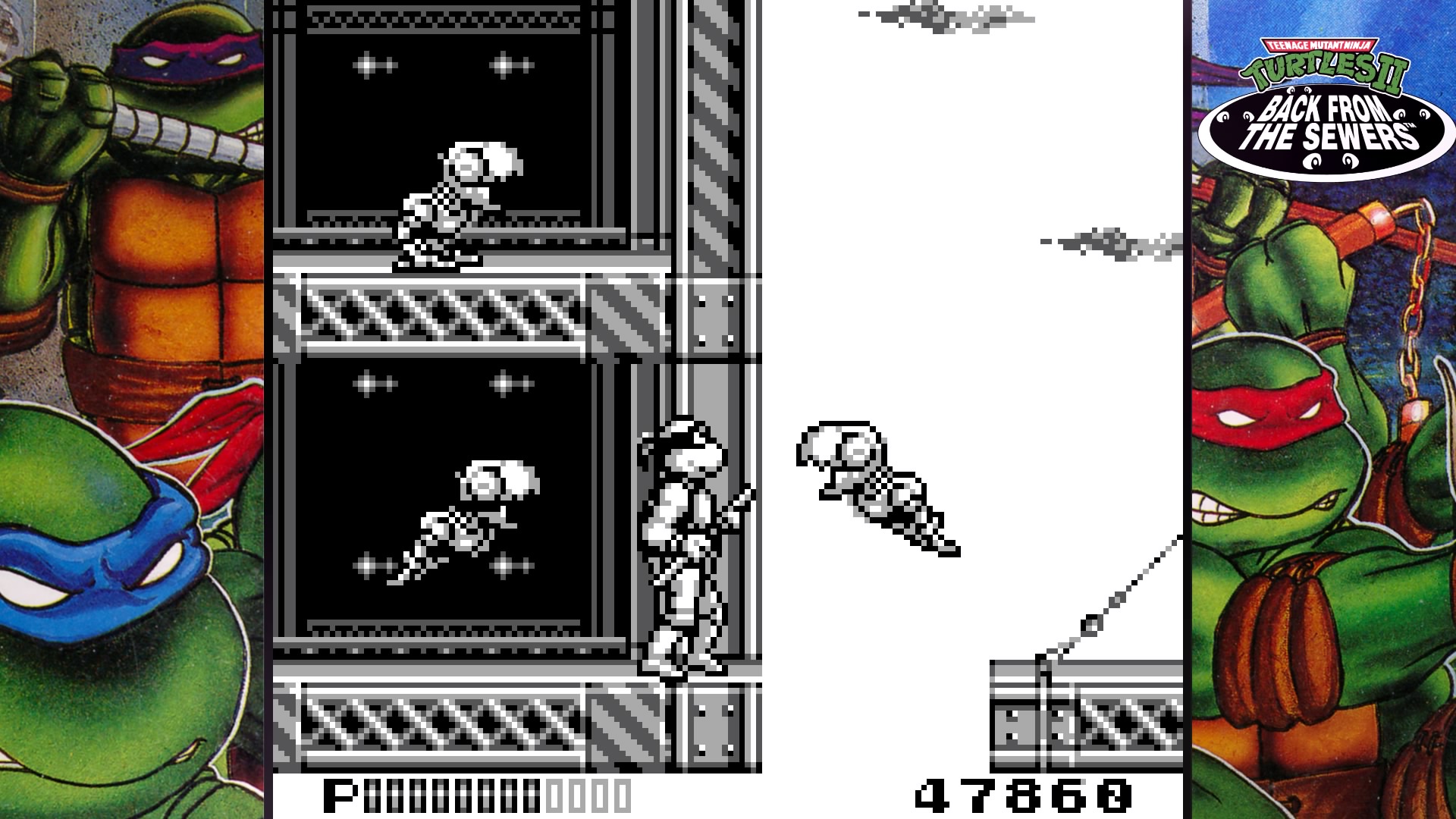
Apologists for the game note that the perfect no-hits run in the video shows you don’t have to heel-toe it. I am so sick of the speed run argument when I complain about a game with pacing issues. The argument is essentially “if you spend enough time to become an expert at a game that already bores you, you can beat it faster.” Well, yeah. That’s usually how it works. But why would anyone want to become an expert at a game they find boring in the first place? There’s like a million games out there. I have better options than a 1991 Game Boy product tie-in that zero effort was put into to actually be fun.
They had more than a year of extra time to work on Back from the Sewers. So, how is it so similar to Fall of the Foot Clan? Actually, change that. How come it’s worse than Fall of the Foot Clan? I’m not going to call Back from the Sewers unplayable. It’s even worse than that. You CAN beat it, but in order to do so, you’re forced to play the game in the most cautionary, plodding, opposite of fun manner I’ve ever seen in any “action” game. Take the same basic enemy attack patterns from the first Game Boy game.. and I mean the EXACT SAME ATTACK PATTERNS, only with different character sprites. Now, have that sequence of attacks happen every time you scroll the screen a half step forward. On “normal” difficulty, the game spawns an absolutely comical amount of enemies that you have to whack with your comically short weapon, then take a step forward and repeat the process. The first game felt like an LCD game that with the limited amount of attack patterns that repeated throughout the game. Well, if that was a Game & Watch, this would be the B mode. The same game, only with the patterns happening at a faster rate. More ambitious level design based on zig-zagging through buildings or aircraft is undermined by enemies or turrets that fire so fast you’re basically forced to take damage. Who on earth wants to play a game where the only way to play well is to essentially crawl your way through it? Back from the Sewers? I think not. This belongs back IN the sewers, because it’s crap.
Verdict: NO!
Cowabunga Collection Ranking: #12 of 13
Teenage Mutant Ninja Turtles III: The Manhattan Project
for the Nintendo Entertainment System
Released February 1, 1992
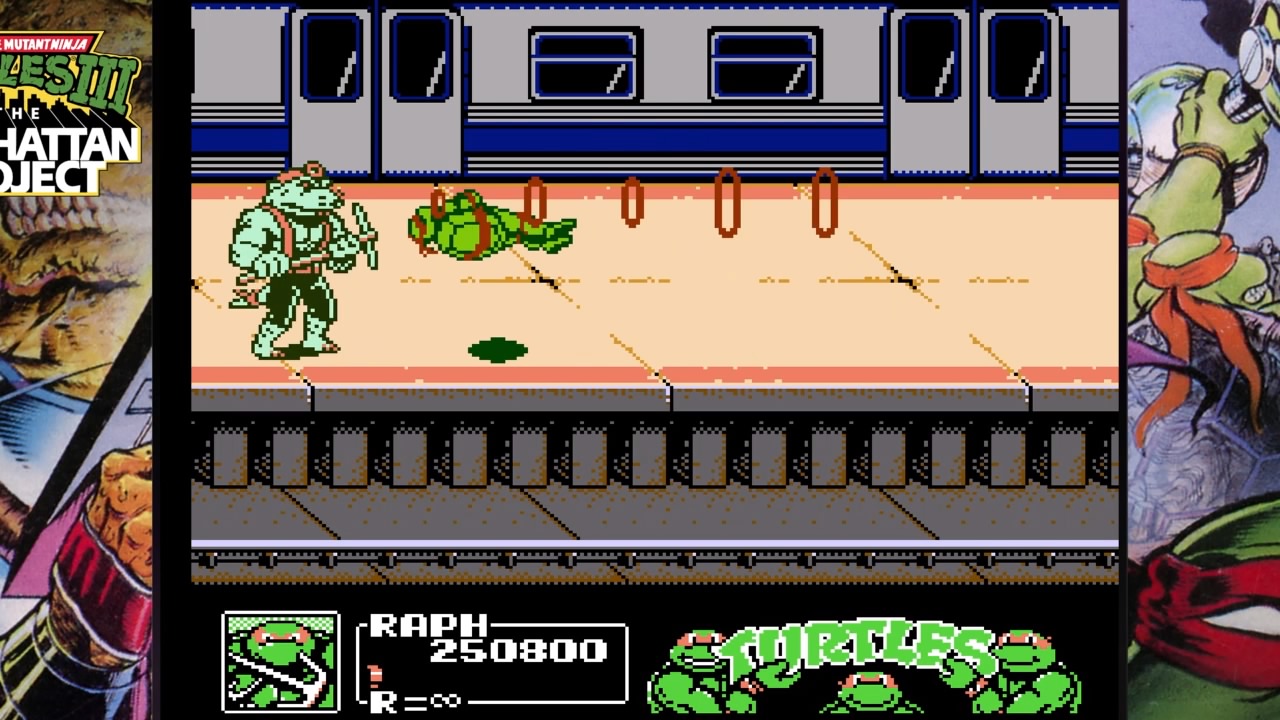
I’ll get my only knock with Manhattan Project’s controls out of the way: it’s too easy to do the life-draining special move. I know that in previous games I complained that it’s too hard, but here I often went to jump to do a drop kick and ended up doing my special move instead. If I hadn’t had infinite lives on, I’d of game-overed just from accidental special move usage alone.

Dinosaurs do not show up at any point at all in this game. Absolutely shameful cover art. Reprehensible, really. If this was a new release, I’d give this a NO! on principle.
To say that I was completely taken by surprise by Teenage Mutant Ninja Turtles III on the NES is an understatement. Here’s what I knew going into it. (1) It used a modified version of the Turtles II: The Arcade Game’s engine, and I hated that game. (2) It’s still the NES, so gameplay is limited to two buttons and stuff that can be done with 8 bits of horsepower. (3) The full-length gameplay video included was nearly two hours long. I could barely keep my eyes from glazing-over playing TMNT II: The Arcade Game and this was over twenty minutes longer. (4) It had a reputation for being insanely difficult. The most frequent thing I heard from players was that it starts fun but finishes with a thud because of prohibitive difficulty. Granted, they likely didn’t have access to the infinite lives that Cowabunga Collection allows you to apply. (5) Konami opted to save a few bucks by not going with the same special chip they used to make Dracula’s Curse possible. Of course, this set allows you to turn off flicker/slowdown inherit to the NES, but the point is TMNT 3 didn’t aspire to max-out the NES’s 1991/92 potential. That’s five completely valid red flags. For those reasons, I’d been dreading the time I’d have to spend with the Manhattan Project more than any other game in the set.
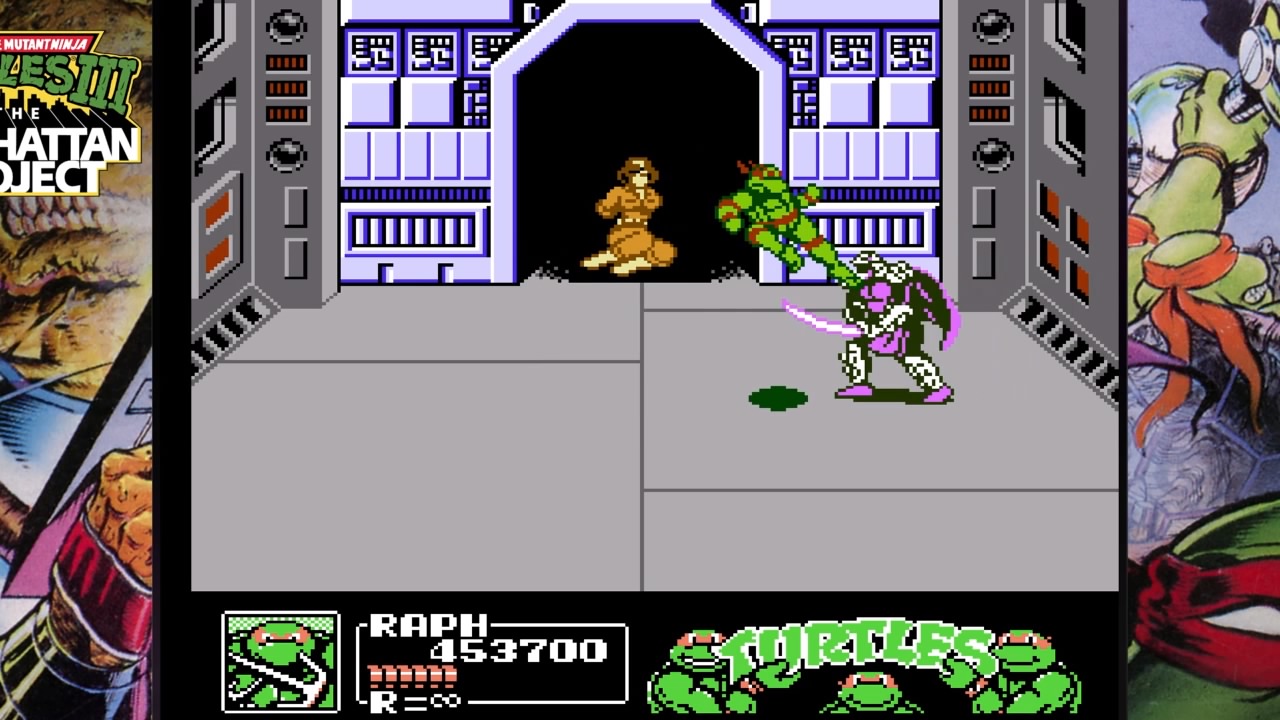
Given the limitations of the fighting engine and the 8-bit console, they kind of got the bosses perfect. This was especially surprising given how boring the bosses in TMNT II were. A big part of that is none of the bosses in Manhattan Project are too spongy. Just when you think they’re about to get boring, the blinking starts, meaning they’re almost dead. Each has a unique style and twist. Most importantly, they’re all fun to battle. Every single one, which is a feat no Turtles game, NOT EVEN SHREDDER’S REVENGE, has pulled off. Only this late-stage NES game. Well done! Outstanding! And one of the most unexpected, delightful surprises of my now five-year-long retro gaming adventures.
My fears were unfounded. Teenage Mutant Ninja Turtles III: The Manhattan Project was pretty awesome. It cleans up most of the things that killed TMNT II on the NES. Collision detection, first and foremost, is completely fixed. There was a couple weird instances involving Michelangelo where his weapon actually had more range than the graphics let on (specifically the “lift over head” move) but those were limited to him. Beyond that, this has some of the best combat collision of any game of this type on the NES. The controls are much more responsive too, and it makes the combat a lot more satisfactory. Plus, this time around, each turtle has their own unique special move. Raphael, who I usually avoid because of his teeny tiny weapons, actually has the best special move by far, a torpedo-like headbutt, and thus he became my primary character. Michelangelo, another turtle I usually avoid using, has a neat handspring kick that, with proper timing, can cause two hits for the price of one. Of course, they fixed the issue with the power moves coming at no cost. This time, whether you hit the move or not, using the special moves takes a tick of health off, and the game is ultra-stingy with the life-refilling pizza so you’ll want to space the special moves out. But, once you get down to your final sliver health, you get unlimited special moves, and with Raph especially, I was spamming them like crazy.
This slideshow requires JavaScript.
Manhattan Project feels like it squeezes as much content out of the formula as two button gameplay on an eight bit console allows. Right up to the eighth and final level, it’s still introducing new enemies. The variety of foot soldiers rivals Shredder’s Revenge, a game released 30 years later. This is a seriously impressive effort. There’s even some unique stage ideas, like an area taking place on a conveyor belt where you have to brawl while jumping over lasers (or not jumping sometimes). I think it went a bit too long. Six levels that had mid-bosses would have worked a lot better, and in fact, the best levels were the ones that had mid-bosses. Two hours is a lot of time to spend with a beat ’em up this limited, though it never becomes fully boring. That’s probably because, unlike Turtles II, TMNT III feels like a labor of love. As for the notorious difficulty, well, some people say that you’re not really beating a game if you cheat and use infinite lives or save states or rewinding. I say, if that’s the only way a game can be enjoyable, so be it. Besides, it’s a brawler and even with one added basic move and unique super moves, it’s still gameplay as shallow as your mother in law’s contempt for you. It’s supposed to be cathartic. Yea, I’m happy I can beat Double Dragon NES if I really put my heart in it, but that also kind of nullifies the fun. You have to buckle down and play efficiently, even if it’s not as fun that way. Without the pressure of playing the game well, I could enjoy TMNT 3 just fine. I could use the basic moves, which are actually FUN to use this time, something the first arcade adaption on the NES completely failed at. Seriously, it’s a chore using the basic moves in TMNT 2, and they don’t feel rewarding when they land. That’s fixed. It’s all fixed. This is as good as an arcade brawler on the NES can be, and kudos to them for pulling it off. Surprise: TMNT 3 is quite fun.
Verdict: YES!
Cowabunga Collection Ranking: #2 of 13
Winner: Biggest Surprise of the Set
Teenage Mutant Ninja Turtles IV: Turtles in Time
for the Super Nintendo Entertainment System
Released August 15, 1992
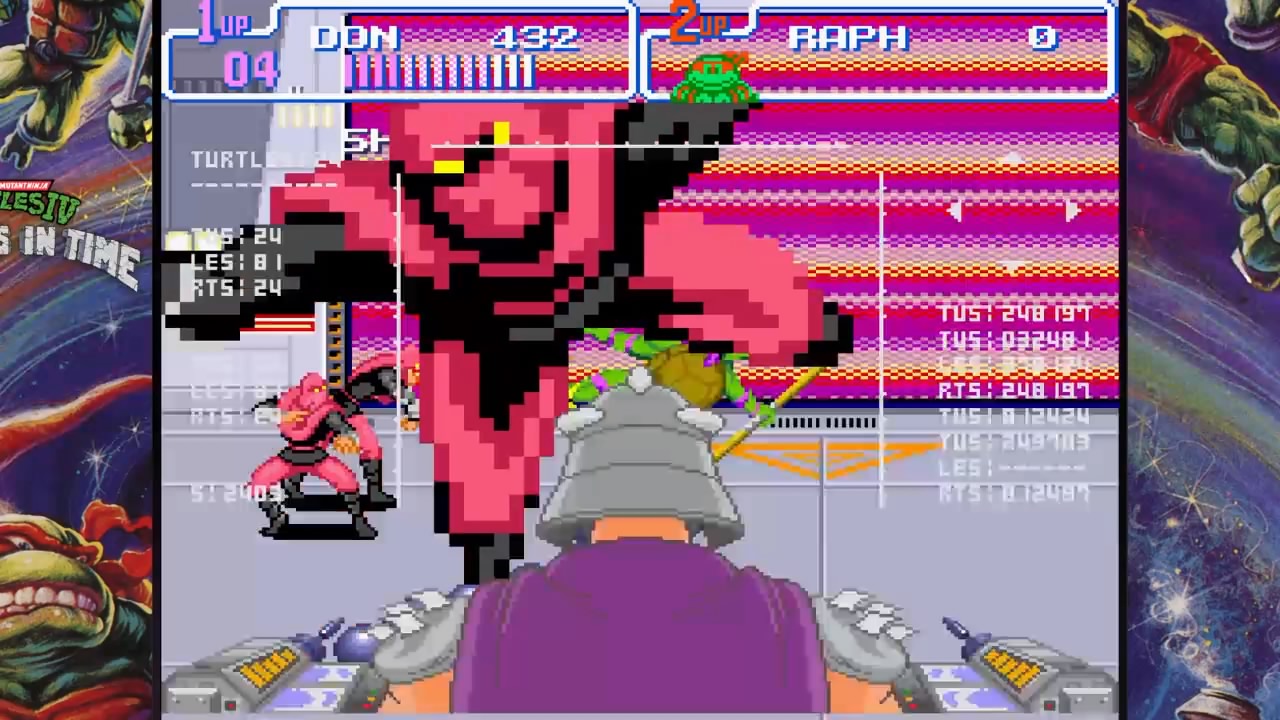
I think this is my favorite boss in any side-scrolling brawler ever made. Someone at Konami must have realized it was just so satisfying to throw foot soldiers at the screen, so they made it a lot easier to pull off on the SNES, then built a boss fight around it. It’ll take something spectacular to top this battle.
Now this is more like it. Despite the arcade game having more fluid animation and sharper graphics, the Super NES version is better in every imaginable way. It controls better. It sounds better (well, okay fine, it doesn’t have most of the arcade’s voice samples or the Pizza Power rap during the attract screen). It plays better. It’s a kinder, gentler lover, like I imagine Shredder really is deep down♥. Turtles in Time on the SNES is a nearly non-stop joy to experience. The feathery, weightless combat of the arcade is replaced with weighty crunches, bone-breaking slams, and weapons that feel like they would actually hurt to get struck by. Whereas the added levels were not to the benefit of the NES game, which was already thin on gameplay and terminally slow, the added content here is welcome. There’s four new bosses and all of them fun to battle. Levels have either been added or heavily altered, including turning the two “surfing” levels into bonus stages, but ones that still have bosses. The Super NES has a lot of great arcade ports, but few actually improve on the coin-op. Turtles in Time MURDERS its arcade counterpart and was likely the best home-to-arcade port until SoulCalibur in 1999.
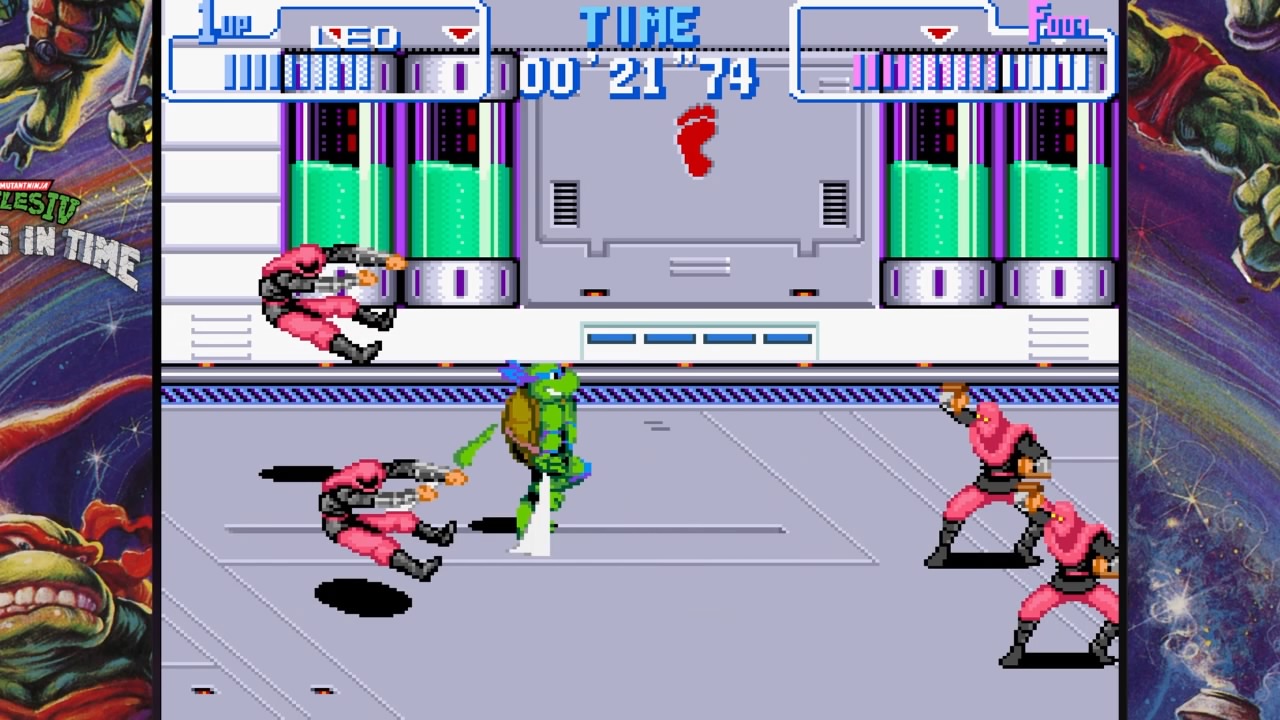
A bizarre extra feature exclusive to this port is the time trial mode. There’s three “courses” that take bite-sized segments from the main game, called “laps” here and times how long you take to beat all the enemies. It’s weirdly slow, as you spend as much time waiting for the next lap to finally load as you do actually “racing” the timer. It’s not the worst idea but the execution is frustrating because of the agonizing wait between laps.
Do you know what my only semi-real problem with Turtles in Time is? I object to the name. Really, the “time travel” aspect barely works. Going back to fight foot soldiers in the dinosaur era? Nice. But the train you’re on could be a train from any time period. Same with the pirate ship. Same with the Technodrome, for that matter. Hell, you have to finish about a third of the game before you even start “traveling through time.” So, yea, the time travel stuff outside of the dinosaur stage and the hoverboard stage is weak sauce. Everything else is superb. A big part of that is the OOMPH (my pet term for violence in a video game feeling like it has real, impactful weight to it) is wonderful. When you hit a strike in Turtles in Time, it feels like it inflicts pain. Which it probably doesn’t because you’re mostly fighting robots but my point still stands. In the arcades, it’s like paper dolls fighting. On the SNES, when you grab an enemy by the limb and start slamming them back and forth on the concrete like Hulk does to Loki in Avengers, it might be my favorite brawling game move EVER. It’s just so damn cathartic, especially when you clear out a screen full of enemies while doing it.
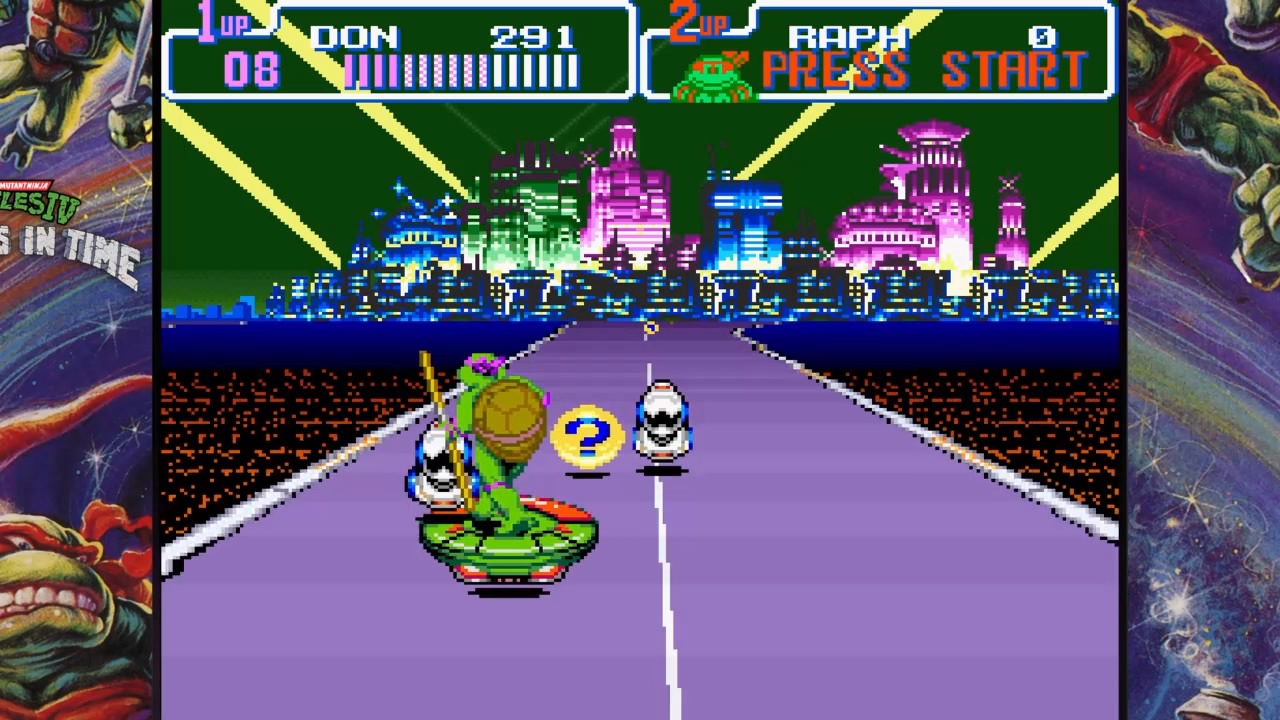
Turning Neo Night Riders into a Mode 7 showcase was another smart move. You’ve already done one “Sewer Surfing” stage. In arcades, it’s just more of the same, and futuristic facade feels paper-thin. On the Super NES, the Mode 7 graphics make it feel fresh and kind of novel. The weird thing about Mode 7 is it shouldn’t impress at all in 2022, but it always makes me sit up and take notice whenever I’m playing any SNES game.
The sound design factors into it, but the controls being a lot more responsive than they are in arcades is the real difference maker. That fluid animation that does look so good in arcades seems to also be why doing combos, getting attacks interrupted, and general unresponsiveness is present. On the SNES, it feels like when you give the command to crush an enemy, it’s done. I could almost do the “slam on the concrete” move at will (which really helps in the time trial mode) and when I needed throw enemies at the screen, I could always do so with minimal effort. Of course, unlike the NES arcade game, just using basic attacks is actually satisfying as well. So is the running shoulder block that makes for the perfect set-up for the concrete slamming. Turtles in Time’s move-set is relatively limited, but what moves you have are very satisfying. My wish list would only include more satisfying/effective aerial attacks.
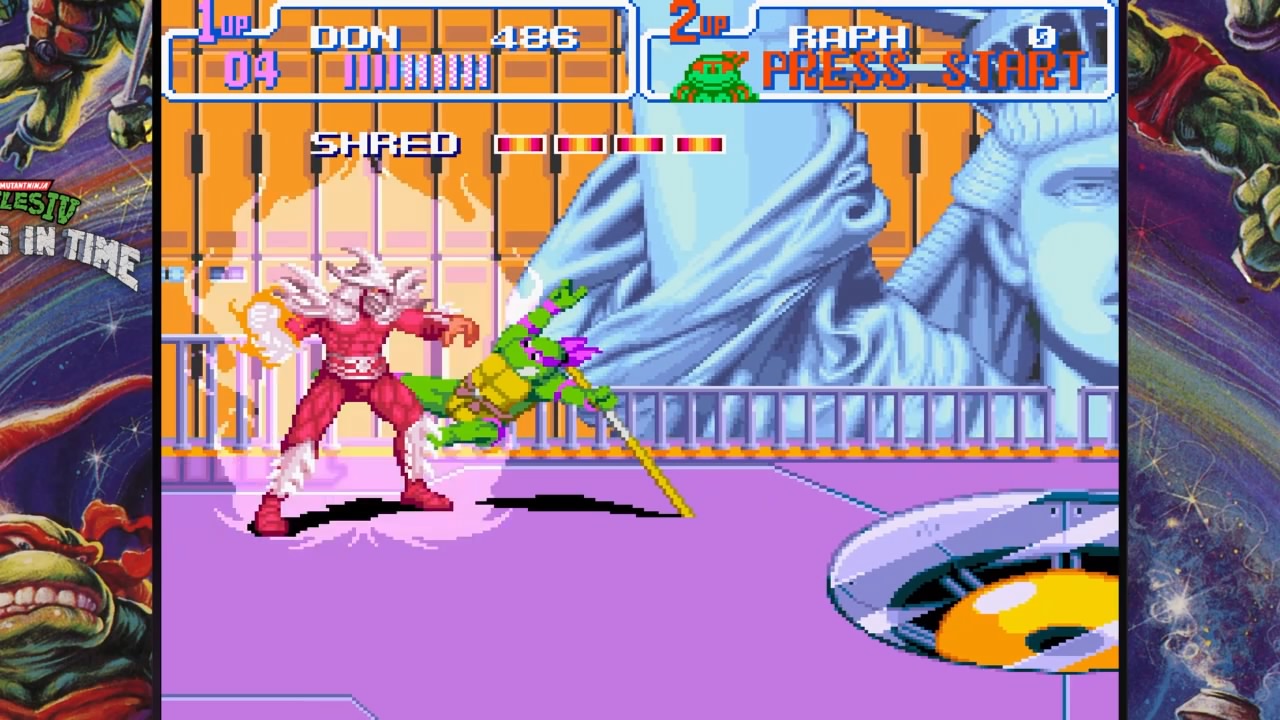
The OOMPH isn’t quite as good against bosses, but hell, even the best Capcom brawlers where you could practically feel the bones shatter also struggled with that too. Boss OOMPH is a tricky balancing act because if you get it wrong, you make the enemy look weak and it takes the stakes out of the fight. One thing Turtles does get right is having all the bosses feel like they’re different. They require different patterns to defeat. You can’t just spam attacks. I like that.
Well, if I’m going to get nit-picky, I guess I wish there was a bigger variety of enemies. It’s mostly just foot soldiers of various colors/weapons. The second most common enemies are these stone guys that aren’t as fun to fight, as when you try to slam them, you just sort of toss them like a sack of potatoes. Rarely, mousers or these giant alien-looking things show up. My hunch is the dev team focused all their energy on the bosses, which was probably wise. The variety of bosses is spectacular and they all feel different, but I’m bummed becuase Turtles in Time was maybe five or six basic enemies away from being the undisputed best brawler of its era. Of course, everything I feel is missing was actually done with the recent Shredder’s Revenge, and probably the best thing I can say about Turtles in Time on the SNES is it set the bar that game had to clear very high indeed. Turtles in Time might not be the best Ninja Turtles game anymore, but that it held that title for twenty years and barely showed any wear from the test of time is a testament to what Konami accomplished here. The SNES port is a truly amazing piece of software and I’m so happy I got to play through it a second time. Let’s leave it here and not re-re-remake it, please. I’d rather have Shredder’s Revenge 2.
Verdict: YES!
Ranking: #1 of 13 **BEST IN SET**
Teenage Mutant Ninja Turtles: The Hyperstone Heist
for Sega Genesis
Released December 11, 1992
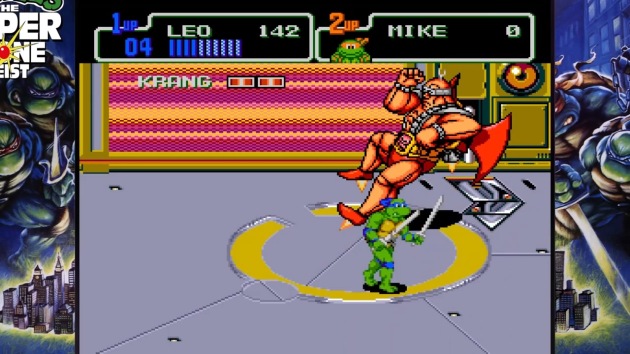
They took the Krang Fight from Neo Night Riders in Turtles in Time, same attack patterns, and made him a boss without the cool futuristic facade or the hoverboards. Like so many things with Hyperstone Heist, it feels stripped-down.
I legitimately can’t believe there’s any debate on which is the superior 16-bit home TMNT arcade game. A lot of people seem to really like Hyperstone Heist. I’ve never seen a game this terrible that has so many people falling over to apologize or make excuses for it, or even call it good. I mean legitimate PASSION from fans who stand by Hyperstone Heist as one of the best, if not THE best, TMNT games ever made. YIKES! I’m not just talking fanboys either, but professional game critics! Hyperstone Heist has made lists like “The 20 Best Genesis Games.” I checked, there’s at least twenty-one Genesis games, which means they’re not awarding this by default. They’ll say “the graphics and sound are better!” Who cares? Turtles in Time in the arcade looks a LOT better than the SNES game, especially the fluid, cartoony animation. But, the gameplay is worse, so the SNES game is better. That’s just how it is. If you value a game having better animation or sound at the cost of gameplay, my reviews are not for you. And while we’re at it, what people consider “better” with Hyperstone Heist is very debatable.
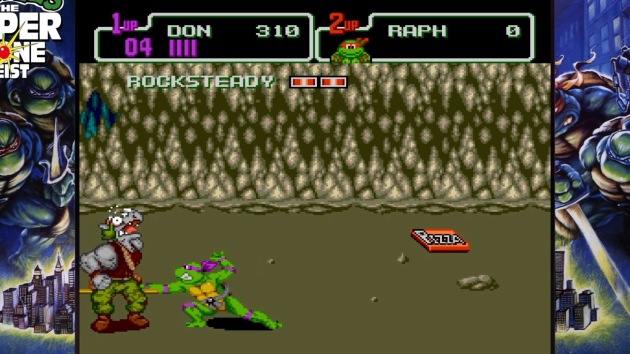
I was already miserable playing Hyperstone Heist for reasons I’m going to get into right about now, but at least I wasn’t completely demoralized. Then a boss showed up I already beat, and I was only on the fourth stage. “Uh oh” I thought, a chill coming over me. Then, after beating Leatherhead for the second time, Rocksteady showed up, and I just felt completely dejected. A goddamned boss rush. And since there had only been three bosses up to that point, it was one of the most pathetic boss rushes I’ve ever seen. Unbelievable. Then it ended with the Baxter Stockman fight from the original TMNT arcade game. Hey, wait.. Rocksteady is in the game but Bebop isn’t? That’s like Simon without Garfunkel! ♫GENESIS DOES! YOU CAN’T DO THIS ON NINTENDO (unless it involves a mutant warthog)!♫
A lot of people lead off with “the music is better!” I’ve never understood why anyone would go to music before gameplay, but fine, let’s start with the music. The Wikipedia page describes Hyperstone Heist as having the same music as other TMNT games, only faster. The faster part I’m not entirely sure was deliberate. It has the same music tracks from previous Turtles arcade games, only they’re sped-up. The thing is, the voices of the Turtles when they die (“ohh, shell-shocked!”) sound like Alvin and the Chipmunks, because they’re ALSO sped up. Then you realize the various bonks and baps from the combat also sound kinda similar, but weirdly so, and it’s because they’re the same sound effects sped-up too. Why would you speed up the sound effects too? That makes no sense at all, unless they just screwed up the soundtrack and sound effects and decided to call it a feature instead of a bug. It must work because people cite the soundtrack as a reason this is better than the SNES counterpart that has more levels, more bosses, more moves, more set-pieces, better play control that makes pulling off advanced moves easier, and has heroes that don’t sound like they’re on an all-helium diet.
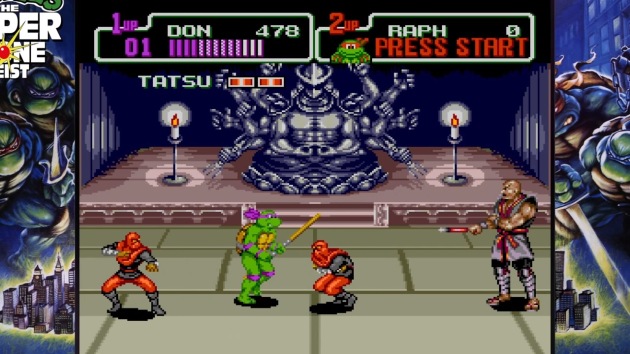
The Sega Genesis version of TMNT has only five levels and six bosses, three of which you have to fight twice, BUT HEY, it has one boss.. ONE SINGLE, SOLITARY BOSS.. that’s not in any other Turtles game. You can practically see the Genesis fanboys showering themselves with confetti while singing “GENESIS DOES WHAT NINTENDON’T!”
But, it’s the claim that Hyperstone Heist has “more aggressive AI” that I object to the most. Apparently it was Konami’s “selling point” for the game. “More aggressive AI” in this case is the most meaningless buzzword on the Genesis since “Blast Processing™©™®™.” But, people fell for it. Reviewers at the time noted the AI was “more aggressive.” The Wikipedia page notes it. People telling me I’m wrong about Hyperstone Heist have said it to me. I don’t know where this “more aggressive” shit comes from, because when *I* played Hyperstone Heist on Normal Difficulty, the enemies kept backing away from me when I walked towards them. They would back all the way to the far-far-far edge of the screen, so much they often weren’t on the screen at all, before they finally stood still long enough for me to kill them. Of course, that means when I hit my strikes, I could only hear that I was doing it and didn’t get the satisfaction of seeing the enemies die. This was consistent from the start of the game until the end. One of my biggest issues with the beat ’em up genre in general is the action too often migrates to the edges of the playfield, but Hyperstone takes it to a new extreme. “Well Cathy, enemies in a real fight WOULD back away from you!” OH FOR THE LOVE OF GOD, IT’S A VIDEO GAME! In real life, a fire breathing, princess-kidnapping turtle dragon wouldn’t choose to make its final stand on a bridge with an axe that the hero could use to drop it into a lake of fire, either, but in the make-believe world of video games, it’d be weird if it didn’t! And it’s weird that so much action in Hyperstone Heist is against enemies you can’t see!
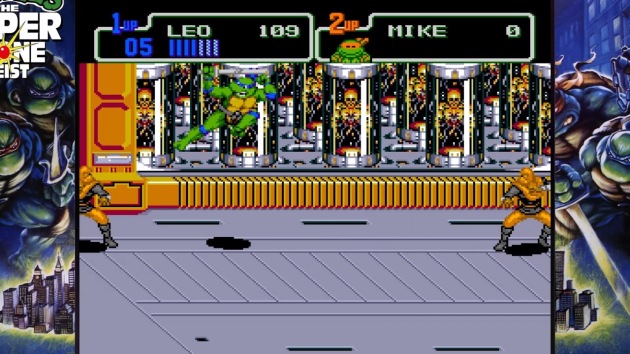
Might as well have put a giant Pizza Hut advertisement in the the center of the screen. It wouldn’t have blocked the action at all.
I think by “aggressive” fans of the game mean the enemies are complete back-fighting, sucker-punching cowards. The overwhelming majority of enemies don’t swarm you. They sort of fall back, and they only move in to attack when your back is turned to them and you start swinging your weapon to the other side. They also have pitch-perfect timing on counter-attacks. But, combat mostly consists of chasing enemies to the edge of the screen for the kill. Many of the enemies are straight-up programmed to just sit on those edges and throw their projectiles in preset intervals. For a game that’s allegedly “faster-paced”, you sure do take FOREVER to get up when you get knocked down. The dramatic knockdown-rolling-sit-up animation is agonizing every time it happens, and most of the time, the enemies begin their attack animation with perfect timing so that you’re going to get hit again at the very nanosecond you make it to your feet. I don’t care how much fans of this game regurgitate Konami’s 1992 marketing of Hyperstone Heist as “more aggressive” and “faster-paced” because the actual gameplay unfolds a lot slower. It’s stop-and-go gameplay on steroids, and thanks to Cowabunga Collection, you can play this side-by-side with Turtles in Time on the SNES and see that it’s actually the SNES game that’s “fast paced” and has more aggressive enemies, because they don’t run away from you like complete lilly-livered yellow-bellied scaredy-cats. Isn’t the point of a brawler being fed an army of cannon fodder to punch?
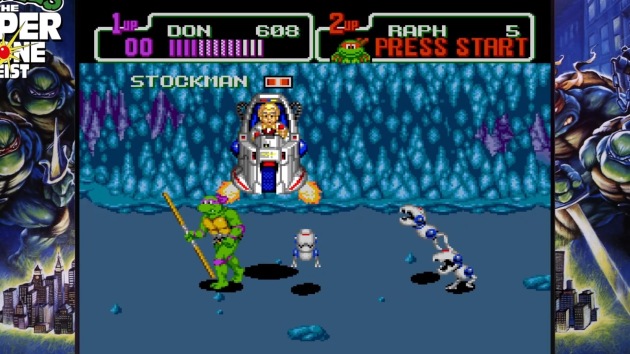
The only nice thing I can say about Hyperstone Heist is it had the most playable version of this Baxter Stockman battle. So hey, +1 for having the best version of my least favorite boss from the original arcade game.
While I’m at it, where is all this other “better gameplay” at? You can’t throw the enemies at the screen, which is one of the most satisfying moves from Turtles in Time. It’s much harder to pull off the “slam enemies into concrete” move, and the other foot soldiers you hit doing it take less damage. Your own life bar can be drained too quickly, as the amount of damage caused by environmental traps or even by random hits from bosses or foot soldiers often is several of your health points. The OOMPH isn’t as good as the SNES game. It has less than half the bosses the SNES game does at 13 to 6. If you object to me counting the fights against Bebop & Rocksteady as two different bosses, and the same for Tokka & Rahzar, the tally is still 11 to 6, a not unsubstantial gap, and the SNES game didn’t make you replay bosses you already beat. “The stages are longer!” Yea, but they don’t do anything. They’re not fun set-pieces at all. I was excited for a “haunted ship” because those can be cool, but it had nothing haunted about it. It was just decrepit. Going off this game’s definition of haunted, my Mom is becoming haunted. So, where’s this better game play? Oh, because the dash button is separate? Well dip me in shit and roll me in bread crumbs, Genesis wins! ♫GENESIS DOES! YOU CAN’T DO THIS ON NINTENDO! GENESIS DOES!♫
This slideshow requires JavaScript.
When presented side-by-side against the SNES Turtles in Time, I can’t understand why anyone would say Hyperstone Heist is the better game, unless they NEED Hyperstone Heist to be better because they still base their self-esteem on the fact that, thirty years ago, Sega successfully marketed their console to them better than Nintendo did (or their parents saved some money buying a Genesis instead of an SNES and then gaslit the kid into believing they really wanted a Genesis all along). Well, sorry Genny fans. The Genesis library beat the SNES library in many ways, but Hyperstone Heist isn’t just bad compared to Turtles in Time. In fact, on its own, compared to no other game, Hyperstone Heist is just boring. An already short game that feels very heavily padded, with bad enemy AI, a limited moveset, and dull set-pieces. But hey, you were told thirty years ago it was faster-paced than other Turtles games and had “more aggressive” AI, even though the AI clearly spends much of the time backing away from the fighting, and who are you going to believe? The best marketing teams money can buy or your lying eyes?
Verdict: NO!
Cowabunga Collection Ranking: #9 of 13
Teenage Mutant Ninja Turtles III: Radical Rescue
for Game Boy
Released November 25, 1993
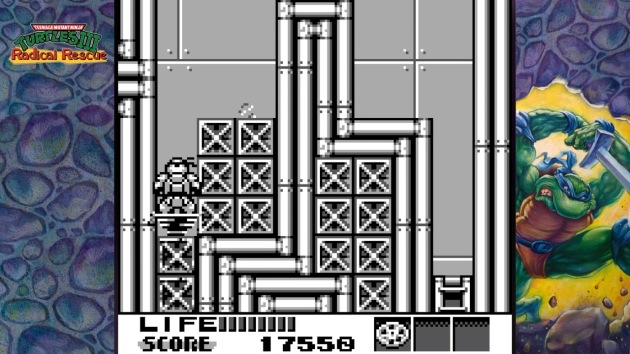
Each of the Turtles has a super power that lets you access a previously unacceptable area. For some reason, Leonardo’s is turning into a drill.
Metroidvanias are my favorite genre, and I’m one of those people that has very little problem with short games. The next IGC review will be an indie NES Metroidvania that takes only a few minutes to complete, and I consider it a perfect game in the sense that the only complaint about it is its ultra-short length, which isn’t really a complaint. I’d rather play twenty to thirty minutes of absolute perfection than two hours of great or six hours of good. Perfection is so much rarer. So, I have no problem with the smallish map and brief runtime of Radical Rescue. Even if you get lost, it probably should only take you under two hours to finish, but that’s fine. I wouldn’t want to be stuck with this game longer. It’s a pretty decent, if basic, Metroidvania that has a major issue with enemy placement and boss fights. This is one of those games where the developers fine-tuned the enemy placement specifically for cheap-shots and unavoidable damage. It happens non-stop throughout the runtime, and it’s such a shame because otherwise Radical Rescue might have become my go-to game for baby’s first Metroidvania.

I have a big problem with the bosses. They don’t quite telegraph their moves enough to give you time to dodge, and man, do they blink a LONG time when you hit them.
The game only has a couple environments that are as bland and flavorless as it gets, and it doesn’t really do a great job of teasing “you’re in a place that you can’t access.. yet, hint hint” that Metroidvanias are ideally built around. But, they actually did a good job of building around starting with Michelangelo and needing to rescue the other turtles. The concept of beating bosses for keys to jail cells works wonderfully. Each of the Turtles has a unique ability required for exploration, which is exactly what I wanted TMNT-NES to do, and I’m gratified that I was right to say it needed it. The boss fights are super annoying. I’ve never seen a game of this type that had the bosses blink with invincibility after taking damage as painfully long as Radical Rescue does. Thankfully, with the glory of save states, you can replay them with no penalty (use the save states over rewinding. Each boss takes a minute or two to beat). Ultimately, the #1 thing I want from a Metroidvania is a good map, and Radical Rescue has a very good map with a nice path to victory that requires the exact right amount of backtracking (or lack thereof) that never becomes annoying. I just wish this had been on a platform like the NES, Genesis, or SNES instead.
Verdict: YES!
Cowabunga Collection Ranking: #4 of 13
Teenage Mutant Ninja Turtles: Tournament Fighters
for Sega Genesis, Super Nintendo Entertainment System, and Game Boy
Released September 4, 1993 (SNES/Genesis) February 1994 (NES)
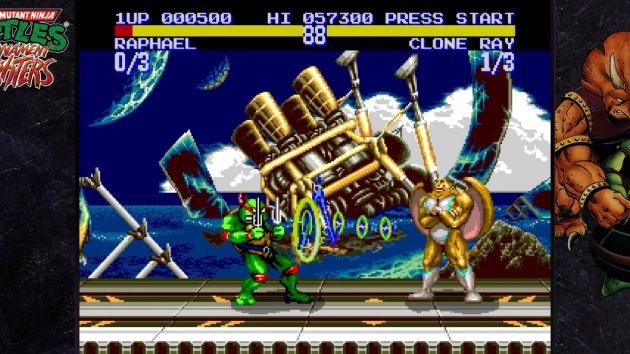
They all have such boring rosters. Oh, and the Genesis version (pictured here) is the only game in all of TMNT Cowabunga Collection that features Casey Jones. That’s an absolute travesty.
I don’t really have a ton to say about the three TMNT Tournament Fighter games. I’ll start by noting the Genesis game is basically unplayable. Of the three buttons they had available, one is used for taunting, which is just stupid. The fighting mechanics are extremely bland and even on the lowest setting, I couldn’t beat the enemy AI. It’s easily the worst game in Cowabunga Collection. If I gave a hypothetical “so bad that it occupies multiple spots in the rankings” for the Genesis version, Back from the Sewers on the Game Boy would be #12, then there would be five to six gaps and the Genesis Tournament Fighters would be #17 or #18. Absolutely abysmal. And you know that Digital Eclipse must have agreed. This is literally the only game in the entire collection that doesn’t have a section in the set’s built-in strategy guide.
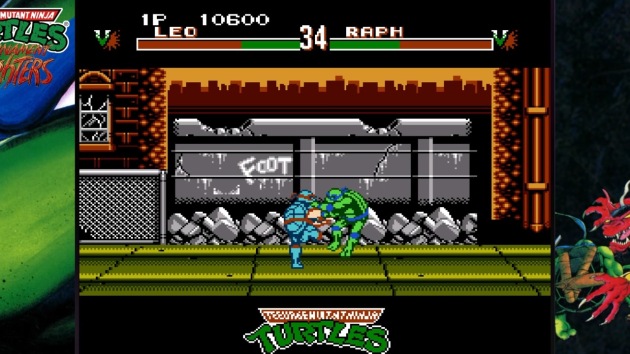
It looks like Raph is kneeing Leo in his nardos here.
The NES game is actually better, but still not fun at all. It feels exactly like one of those modern “demakes” that you’ll see indie developers come up with as a cutesy novelty. You can only choose to use the Turtles in the one player mode, and once again, the AI is just too dang good. The big difference in this one is a dodgeball will occasionally be dropped onto the playfield for the players to use. The only nice thing I can say about the NES game is that I’d rather play it than Back from the Sewers on Game Boy.
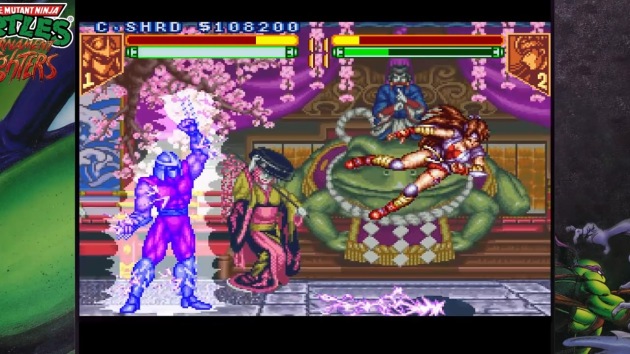
I don’t understand the whole “Cyber Shredder” thing. That’s what he’s called in Radical Rescue too. Does he have online sex or something. Because I’d totally cyber with him. Damnit, I can change him!
Really, the SNES game is the only one of interest. Four button gameplay for heavy and light punches and kicks, so at least the action has substance and nuance to it besides button mashing. The OOMPH! is decent, there’s a nice variety of special moves, and the super move meter that penalizes usage of the block was ahead of its time and inspired. So, why didn’t I like it? Honestly, this felt to me like one of the more bland entries in SNK’s fighting game franchise. Besides Shredder and the Turtles, I didn’t recognize any of the characters, and the only fun character to play as is Shredder. The weird game show-like theme between stages threw me off, and frankly, I didn’t think the fighting was all that. It felt like they aimed for competent more than spectacular. I think a modern Turtles fighting game with cel-shaded graphics could be interesting, but for its time, this was just a wannabe Street Fighter that might have worked for kids in 1993 who recognized the characters. For a non-TMNT fan in 2022, this wasn’t for me.
Verdict: NO!, NO!, and NO!
Cowabunga Collection Rankings
SNES: #6 of 13 **BEST OF THE WORST**
NES: #11 of 13
Genesis: #13 of 13
A review copy for Teenage Mutant Ninja Turtles: The Cowabunga Collection was provided by Konami for this feature.







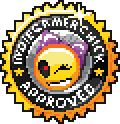 Project Blue is Chick-Approved
Project Blue is Chick-Approved Project Blue was developed by toggleswitch, FrankenGraphics, and M-Tee
Project Blue was developed by toggleswitch, FrankenGraphics, and M-Tee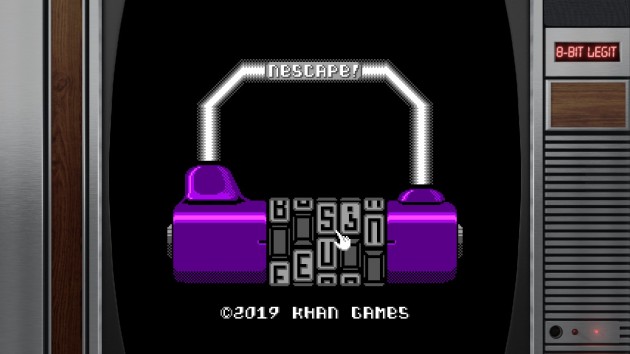
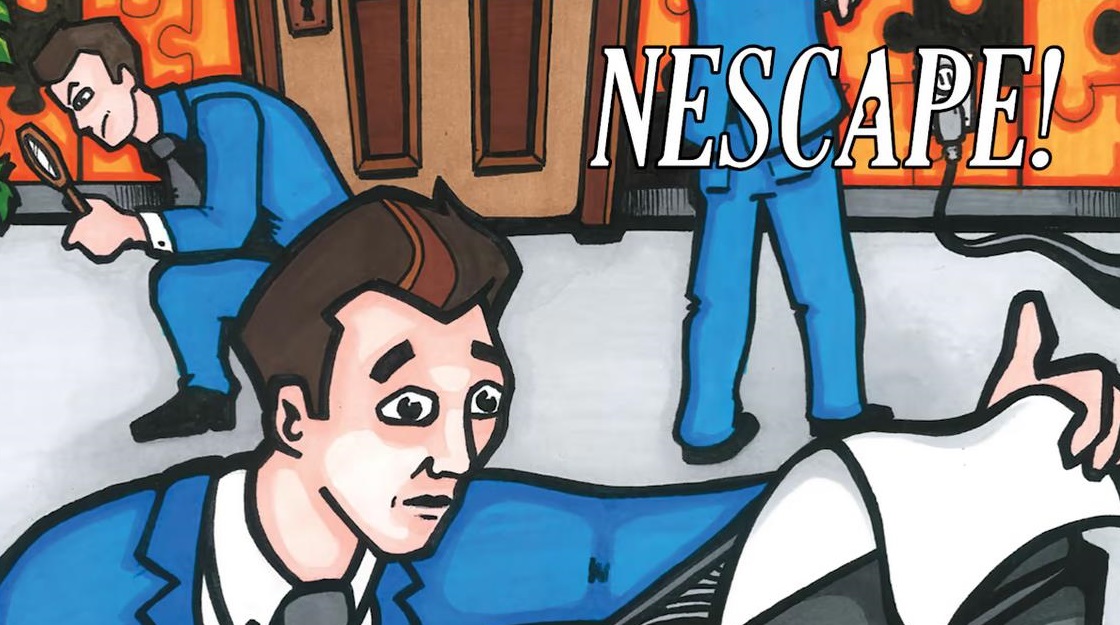
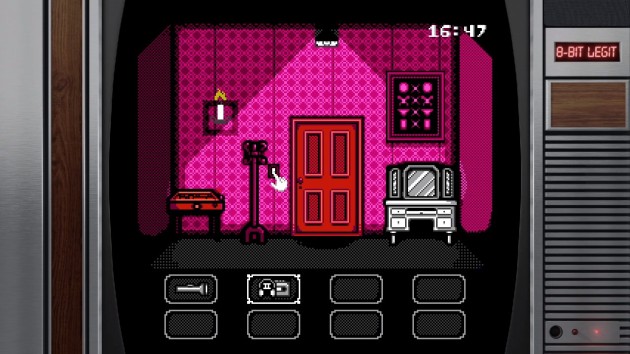

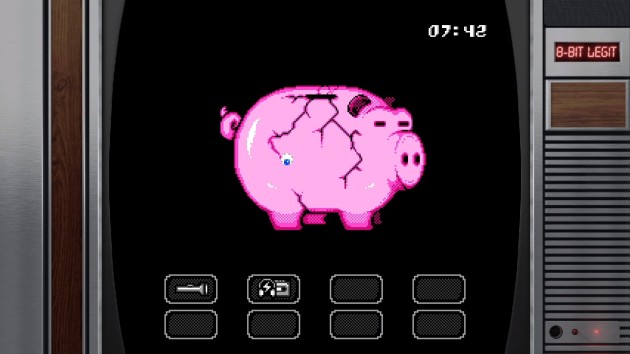

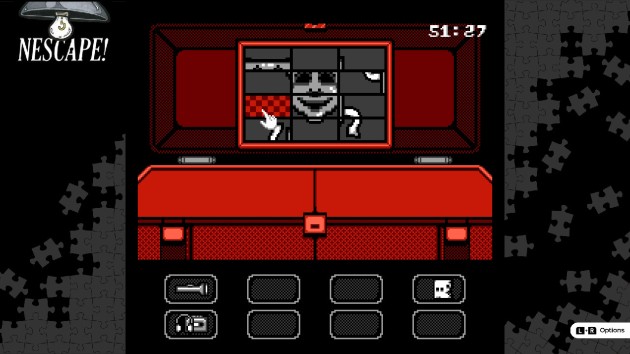
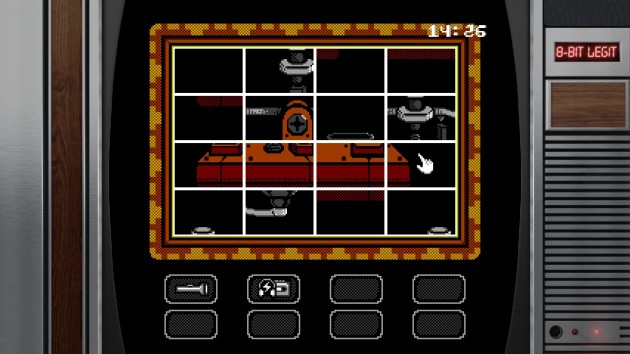
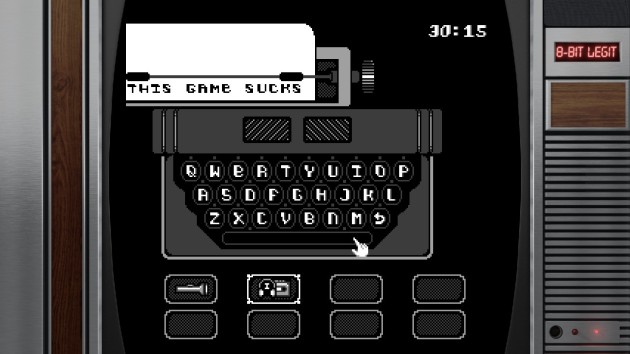
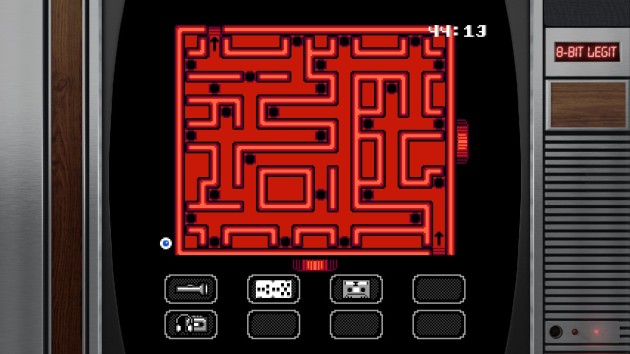
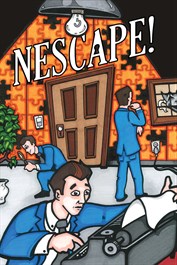 NEScape! was developed by KHAN Games
NEScape! was developed by KHAN Games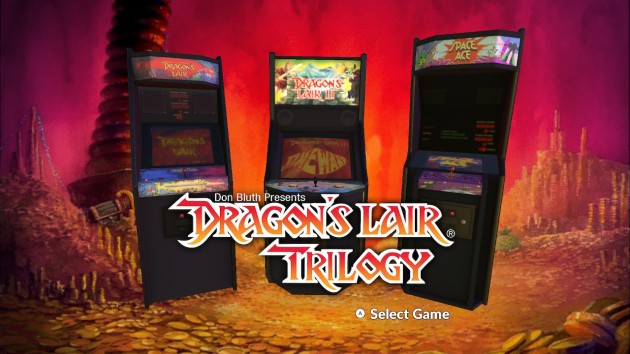
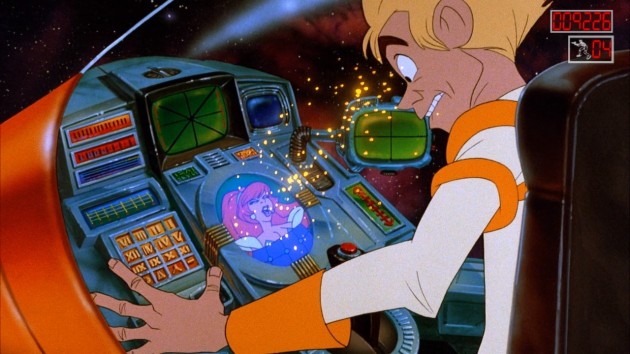
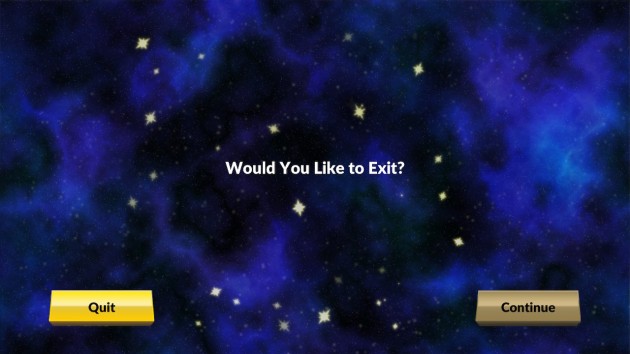
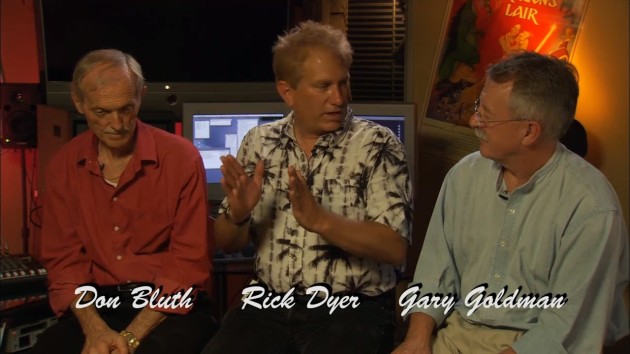
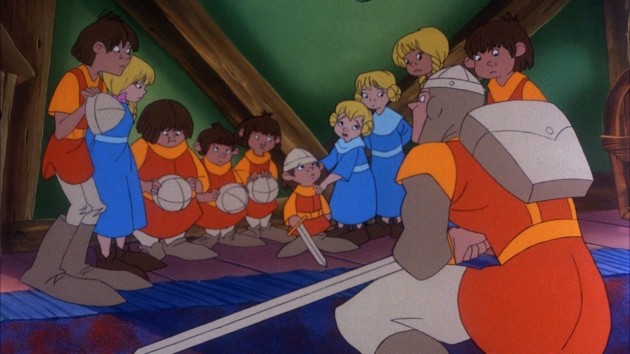


 Dragon’s Lair
Dragon’s Lair
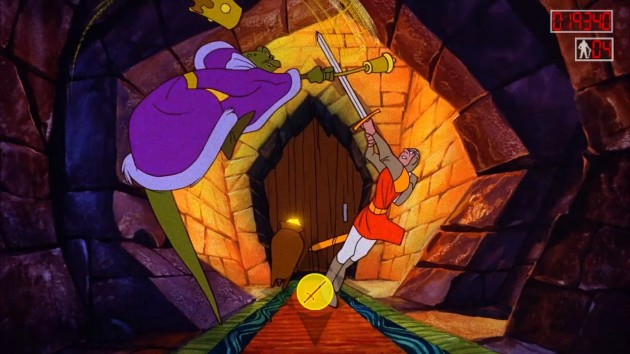
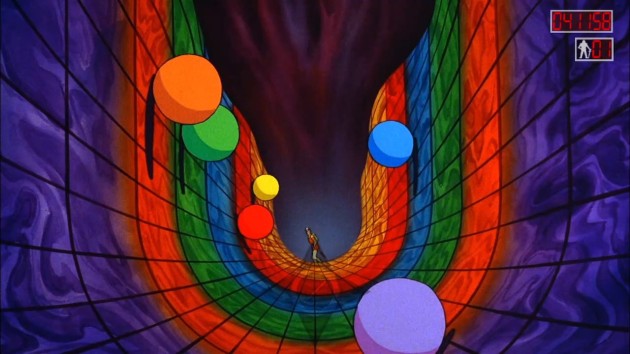
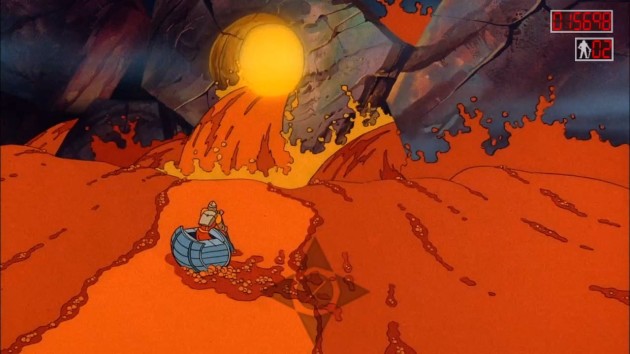
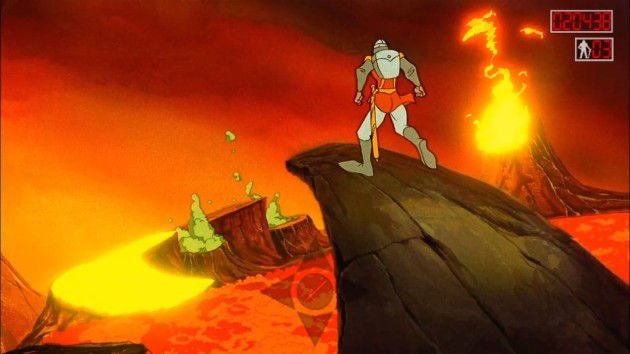
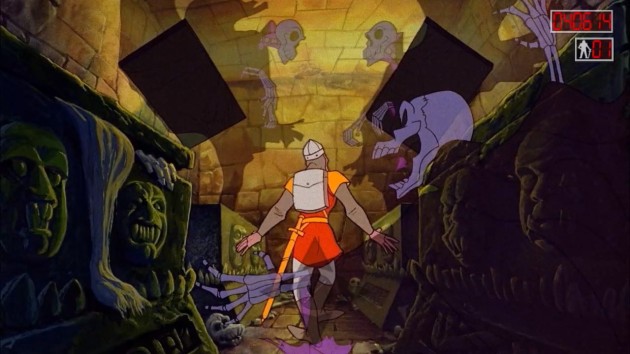
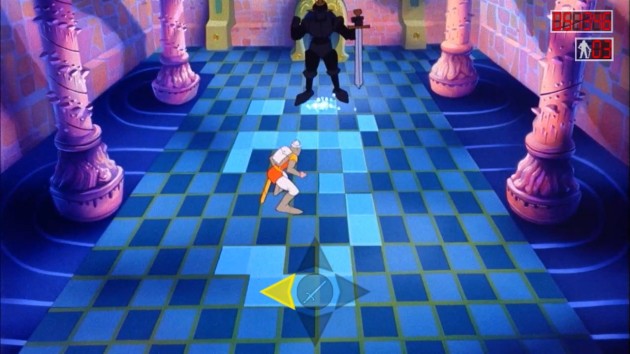
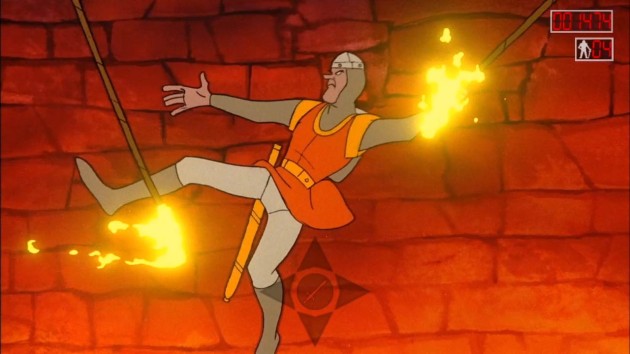

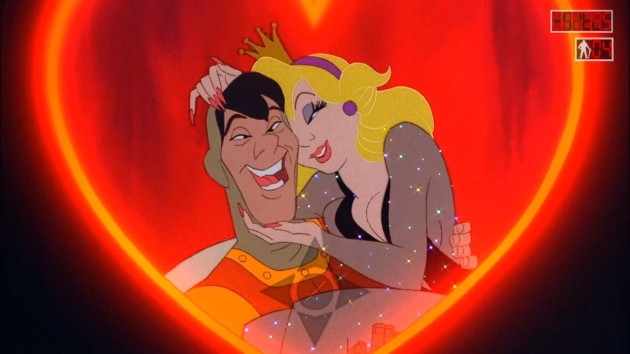
 Dragon’s Lair II: Time Warp
Dragon’s Lair II: Time Warp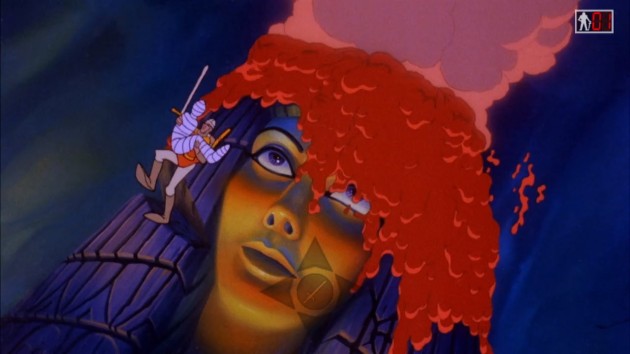
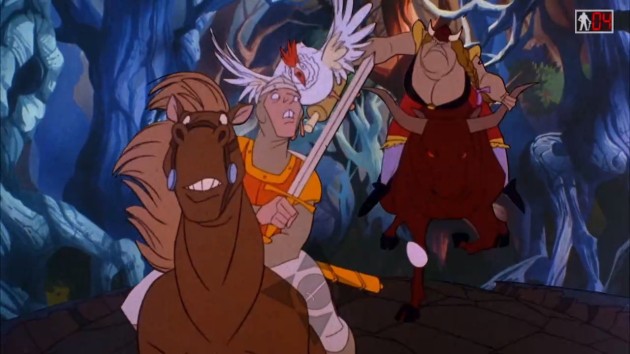
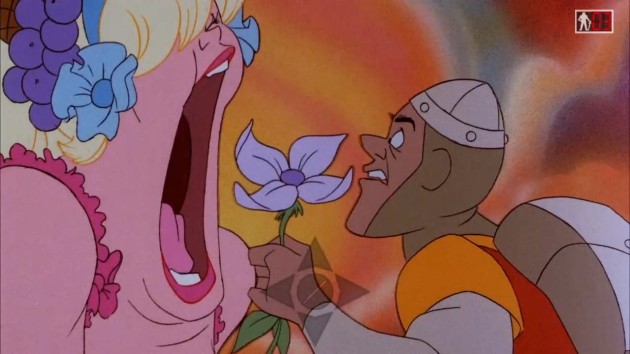
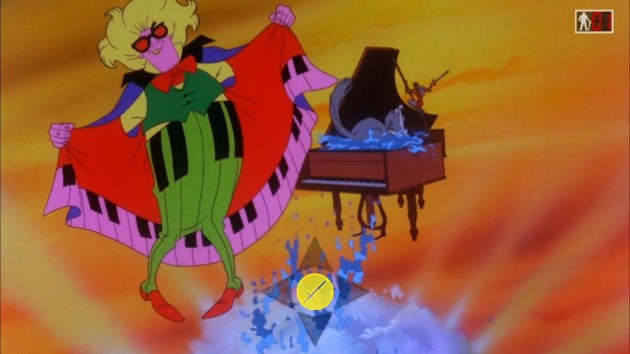
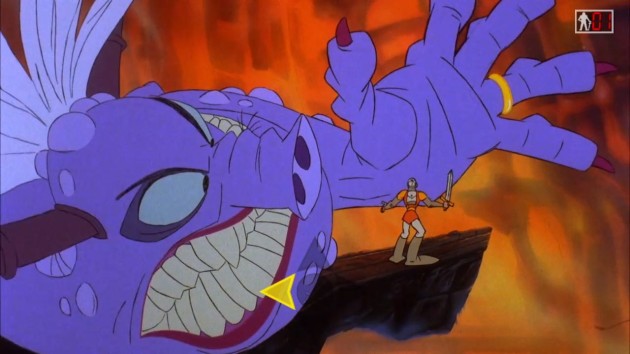
 Space Ace
Space Ace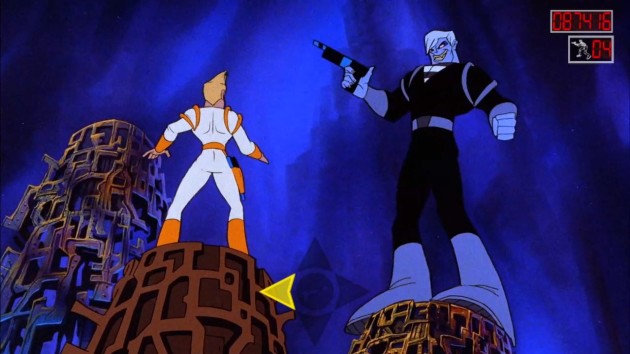
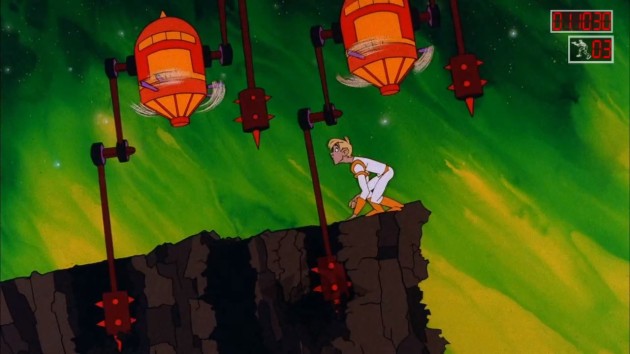
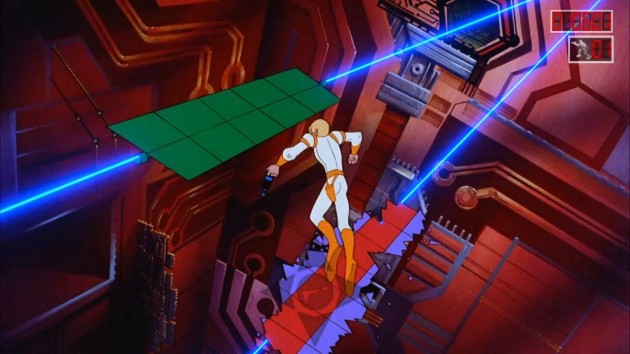
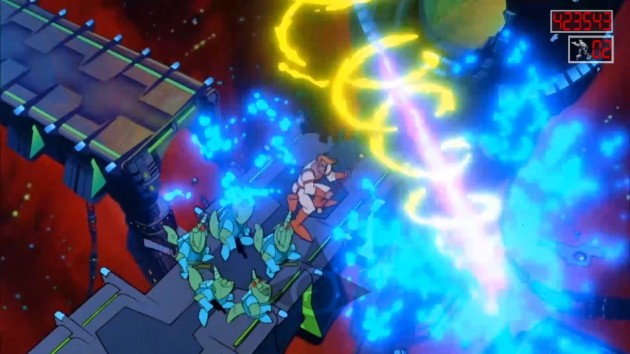
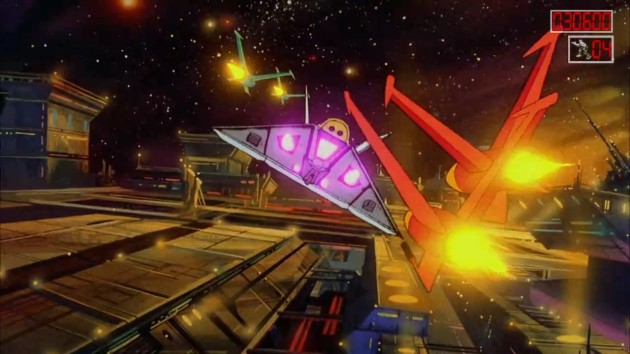
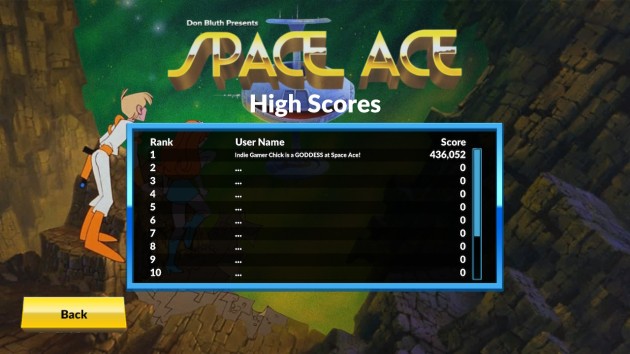
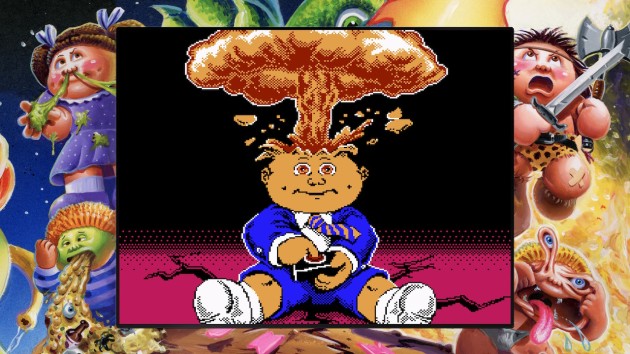
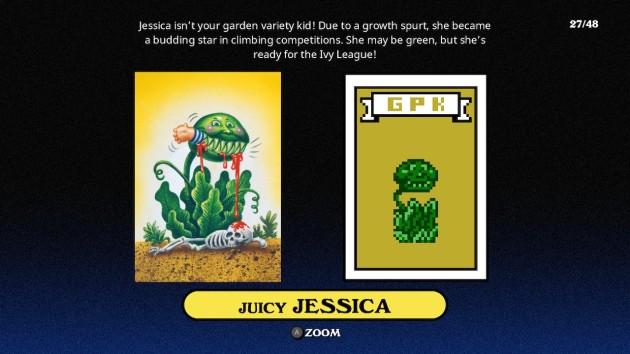
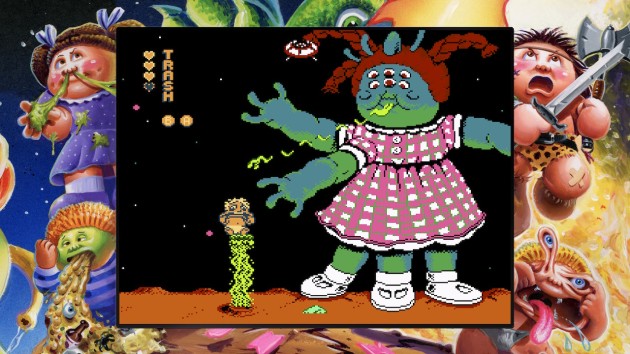
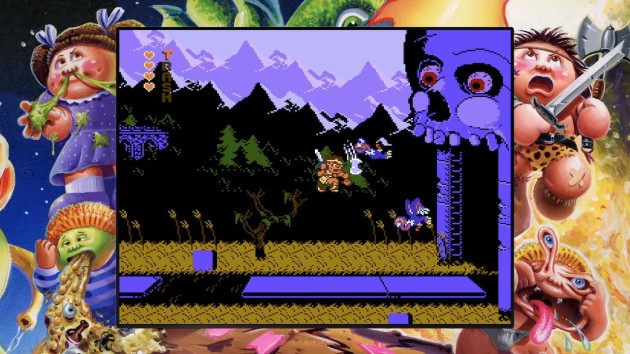
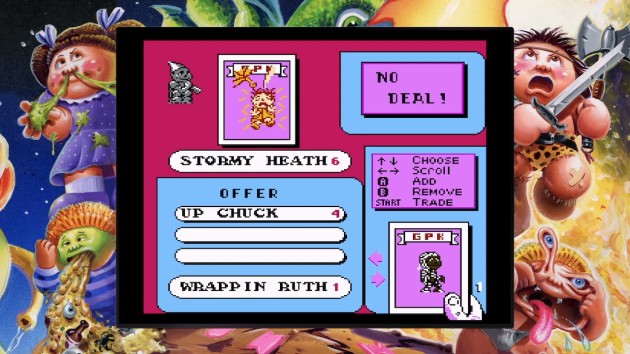
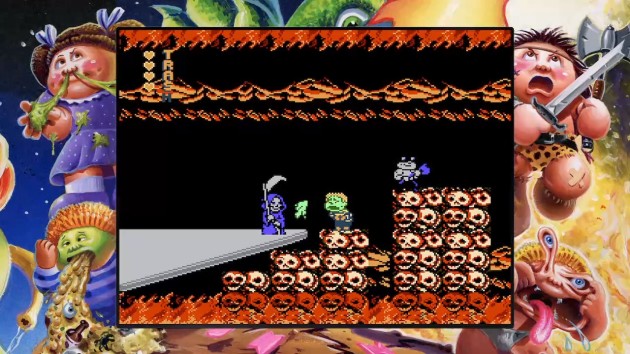
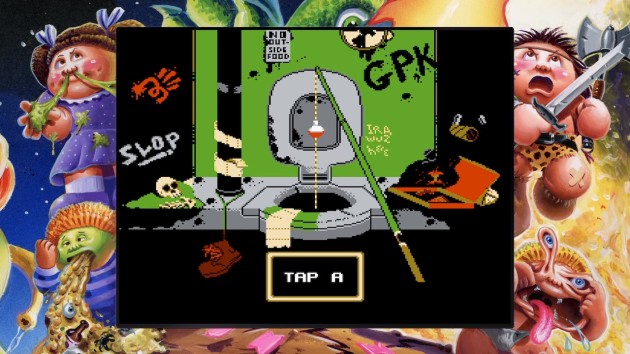
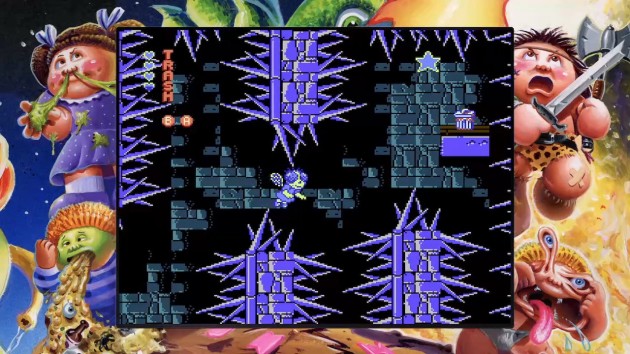
 Garbage Pail Kids: Mad Mike and the Quest for Stale Gum is Chick-Approved
Garbage Pail Kids: Mad Mike and the Quest for Stale Gum is Chick-Approved Garbage Pail Kids: Mad Mike and the Quest for Stale Gum was developed by Retrotainment
Garbage Pail Kids: Mad Mike and the Quest for Stale Gum was developed by Retrotainment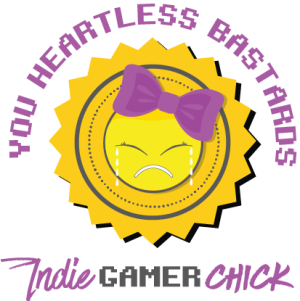 Yea, a big part of it going so far under the radar is it got its start on Xbox Live Indie Games. So did I, and like me, it’s been stuck with a following that can be generously described as modest at best. But, at least I have a valid excuse: I ain’t everybody’s cup of tea. On the surface, Escape Goat doesn’t seem like it will be either. It’s a puzzler, and eleven years of staring at my traffic figures has given me an inkling that puzzlers are a tough sell for most gamers. So, what if I told you that Escape Goat is really an action game and that puzzles are the setting but not necessarily the genre?
Yea, a big part of it going so far under the radar is it got its start on Xbox Live Indie Games. So did I, and like me, it’s been stuck with a following that can be generously described as modest at best. But, at least I have a valid excuse: I ain’t everybody’s cup of tea. On the surface, Escape Goat doesn’t seem like it will be either. It’s a puzzler, and eleven years of staring at my traffic figures has given me an inkling that puzzlers are a tough sell for most gamers. So, what if I told you that Escape Goat is really an action game and that puzzles are the setting but not necessarily the genre?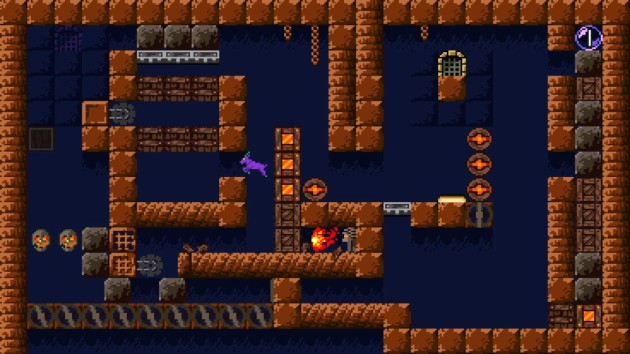

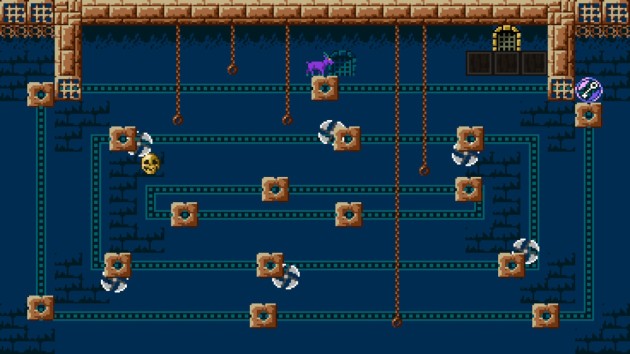
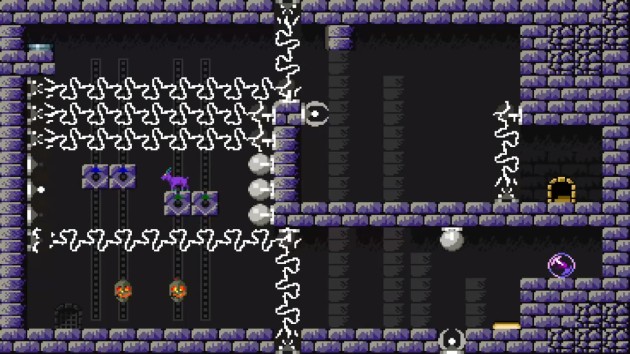
 Escape Goat is Chick-Approved
Escape Goat is Chick-Approved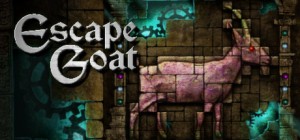 Escape Goat was developed by Magical Time Bean (Published on Switch by
Escape Goat was developed by Magical Time Bean (Published on Switch by 





 Teenage Mutant Ninja Turtles: The Cowabunga Collection is Chick-Approved. Having an official re-release of Turtles in Time for the SNES is a pretty amazing thing, but this collection has a few surprises as well. I didn’t expect to like the original arcade game, and in fact, I enjoyed my time with it a lot. I didn’t expect to like any of the Game Boy games, but two of them were acceptable time wasters. I certainly didn’t expect to enjoy the two hours I spent with Manhattan Project for the NES, yet here we are. Five totally solid Turtles games, emulated to perfection, plus a whole lot of bonus material, makes this a set worthy of purchase.
Teenage Mutant Ninja Turtles: The Cowabunga Collection is Chick-Approved. Having an official re-release of Turtles in Time for the SNES is a pretty amazing thing, but this collection has a few surprises as well. I didn’t expect to like the original arcade game, and in fact, I enjoyed my time with it a lot. I didn’t expect to like any of the Game Boy games, but two of them were acceptable time wasters. I certainly didn’t expect to enjoy the two hours I spent with Manhattan Project for the NES, yet here we are. Five totally solid Turtles games, emulated to perfection, plus a whole lot of bonus material, makes this a set worthy of purchase.









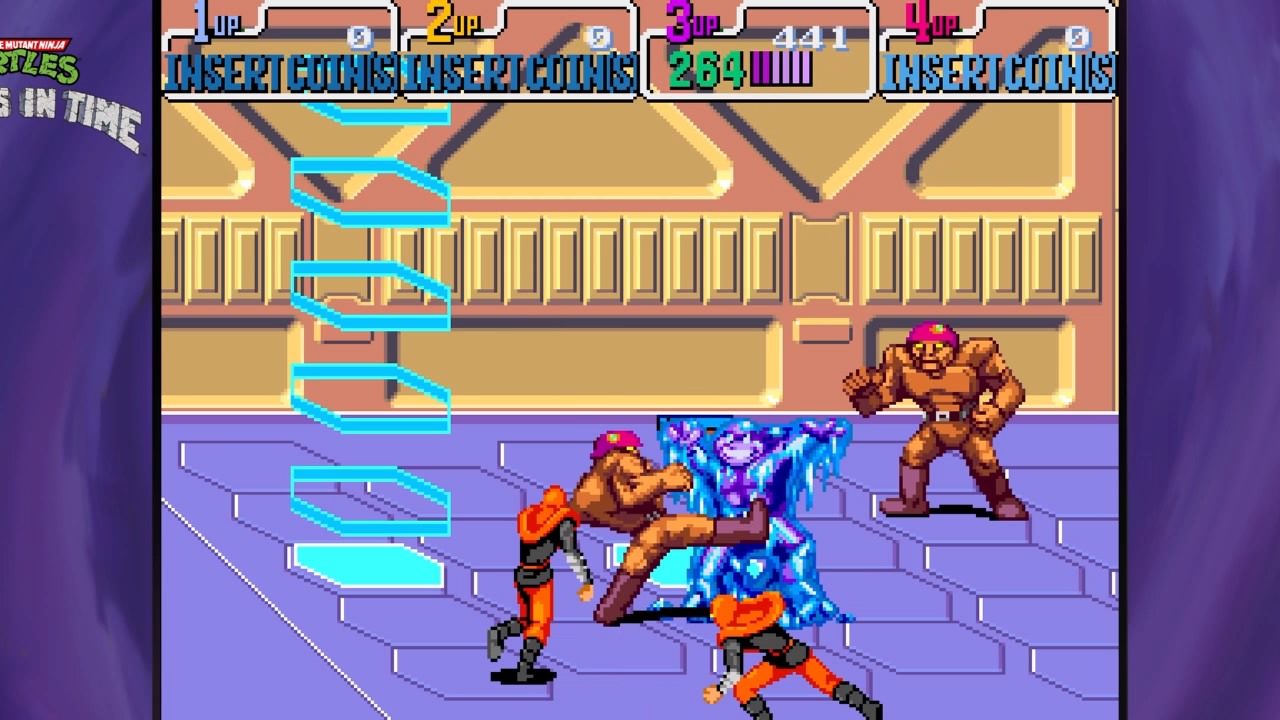


















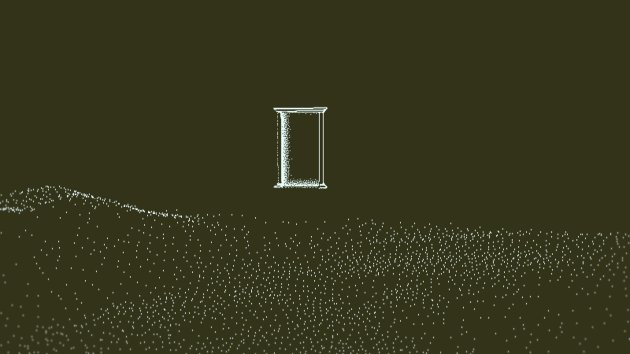
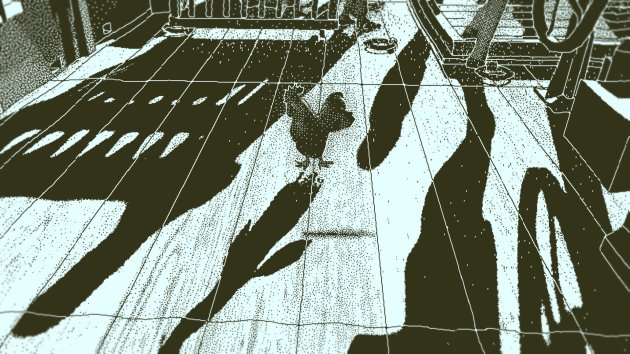
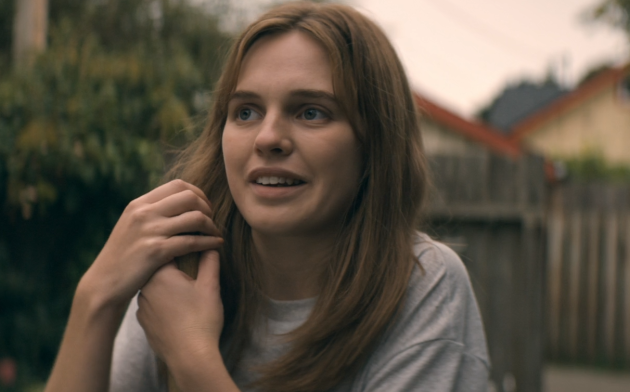
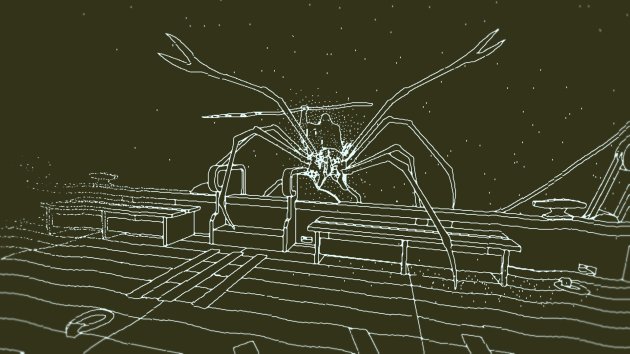
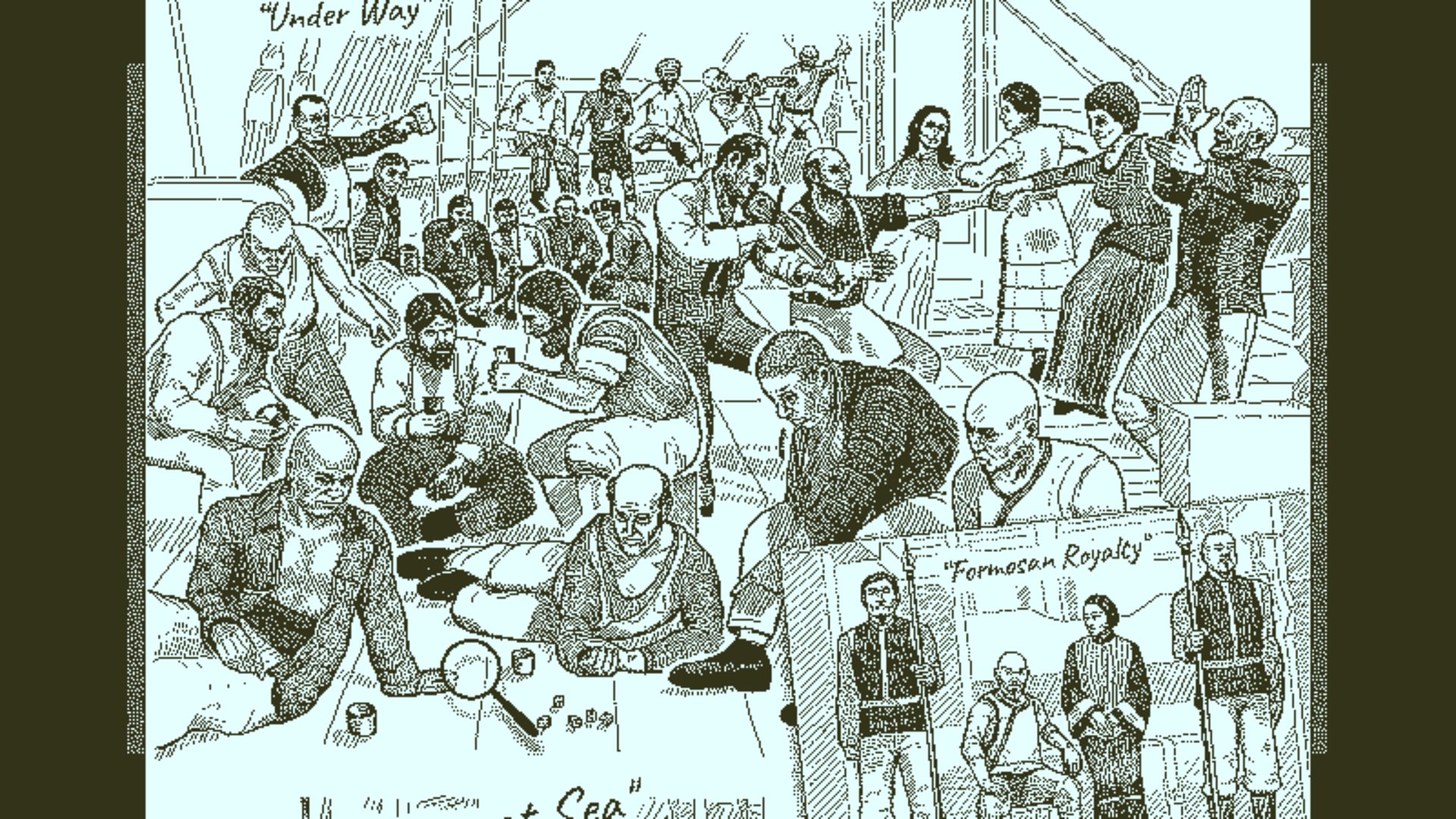
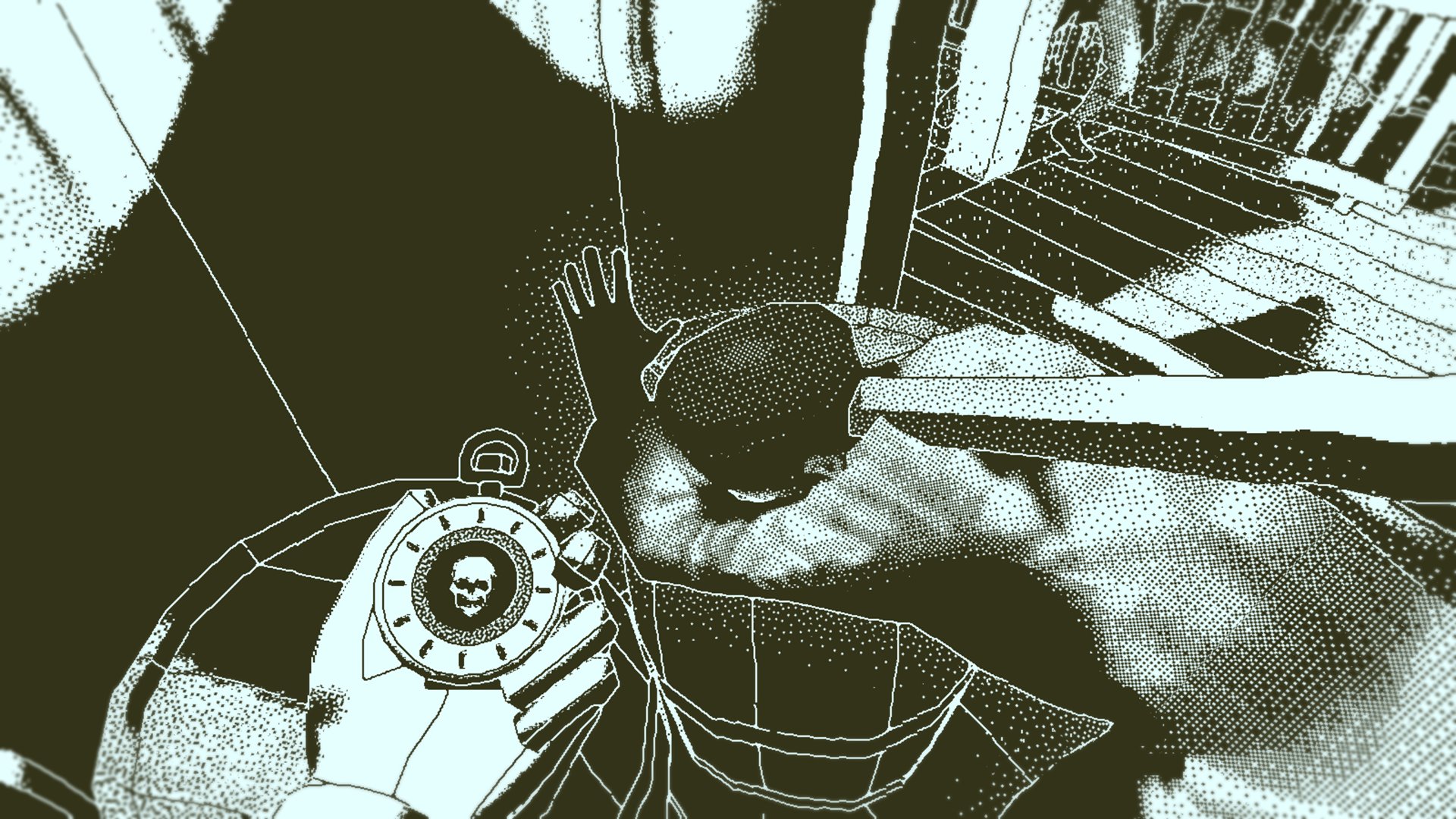
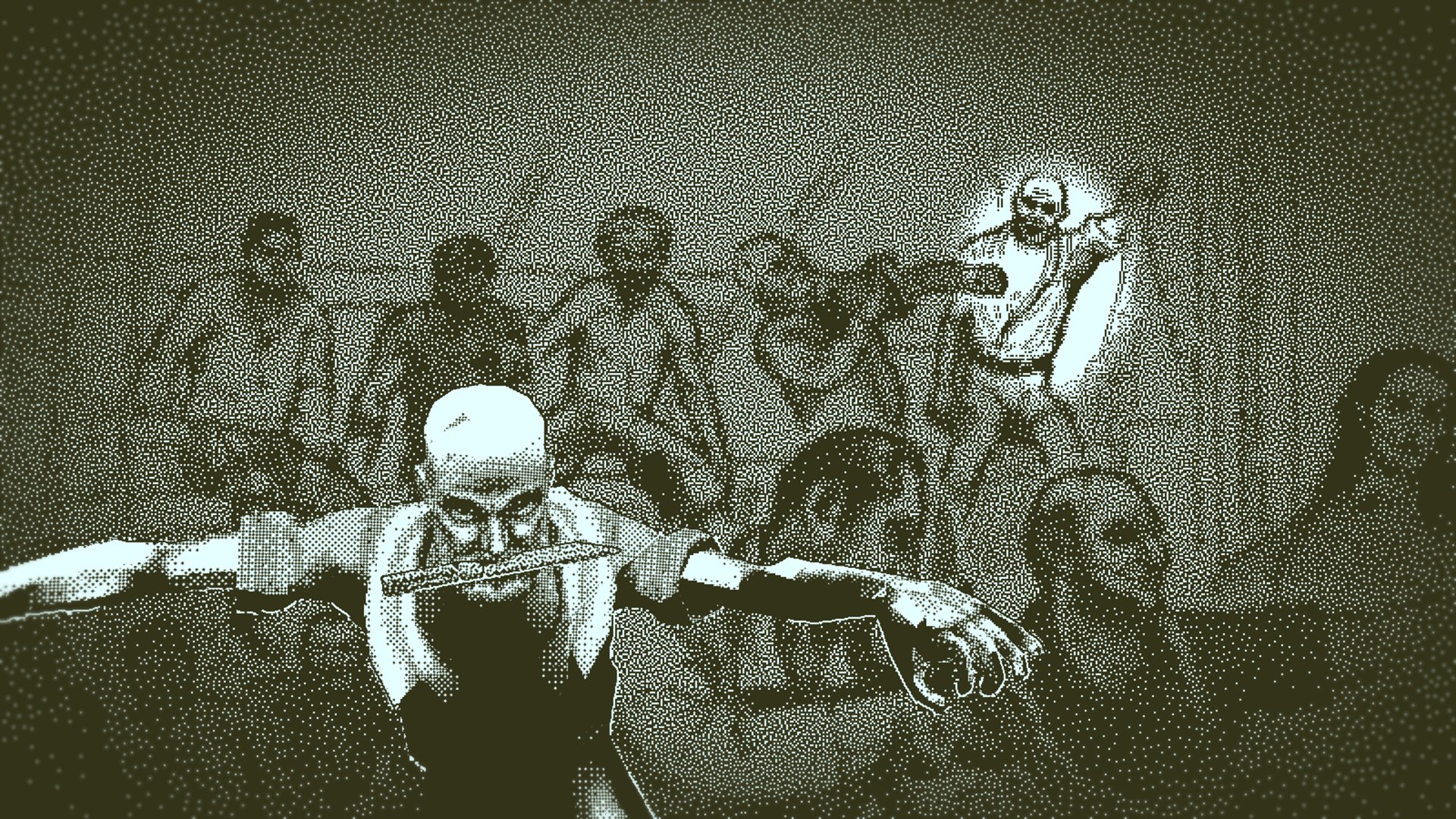
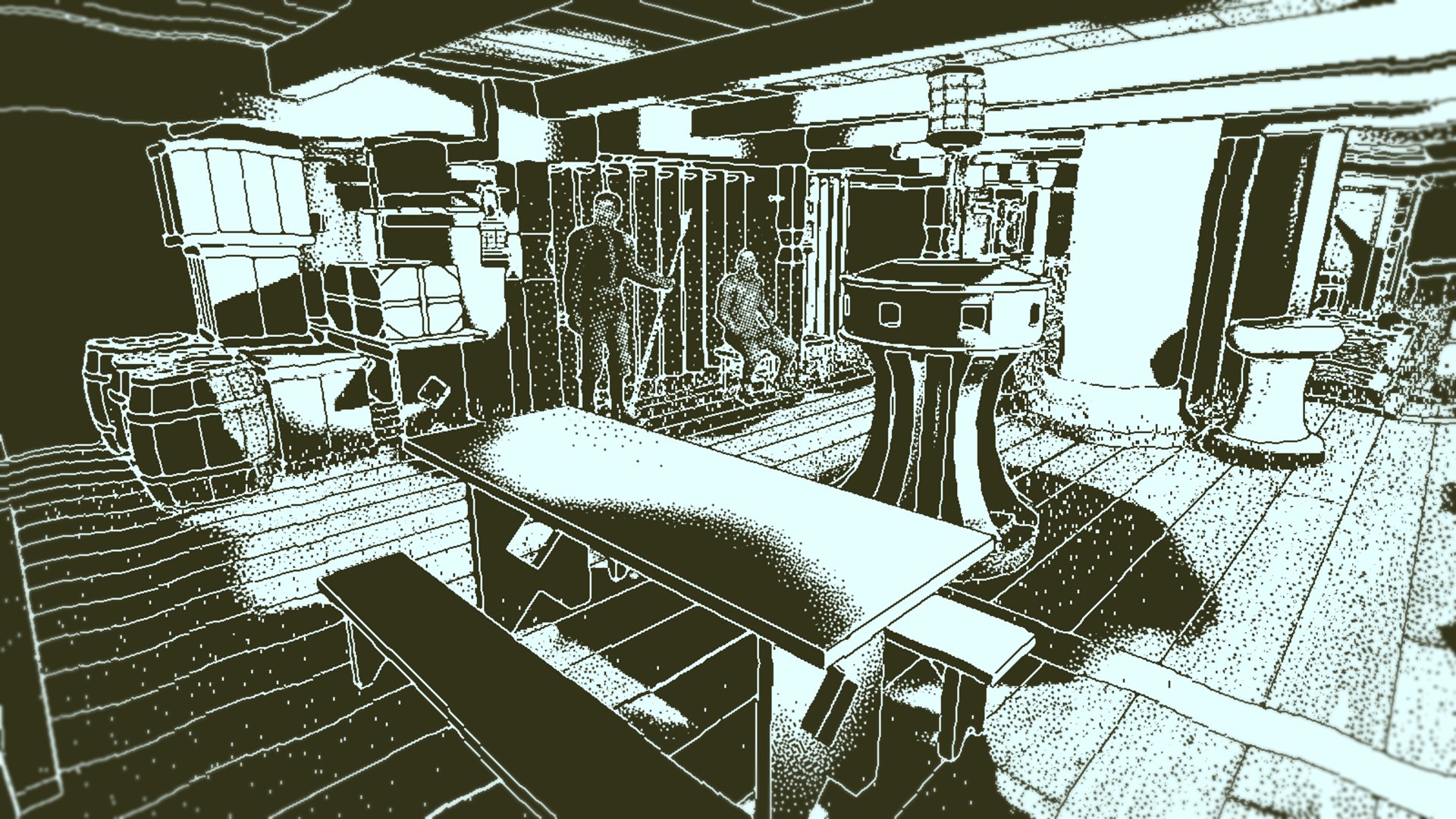

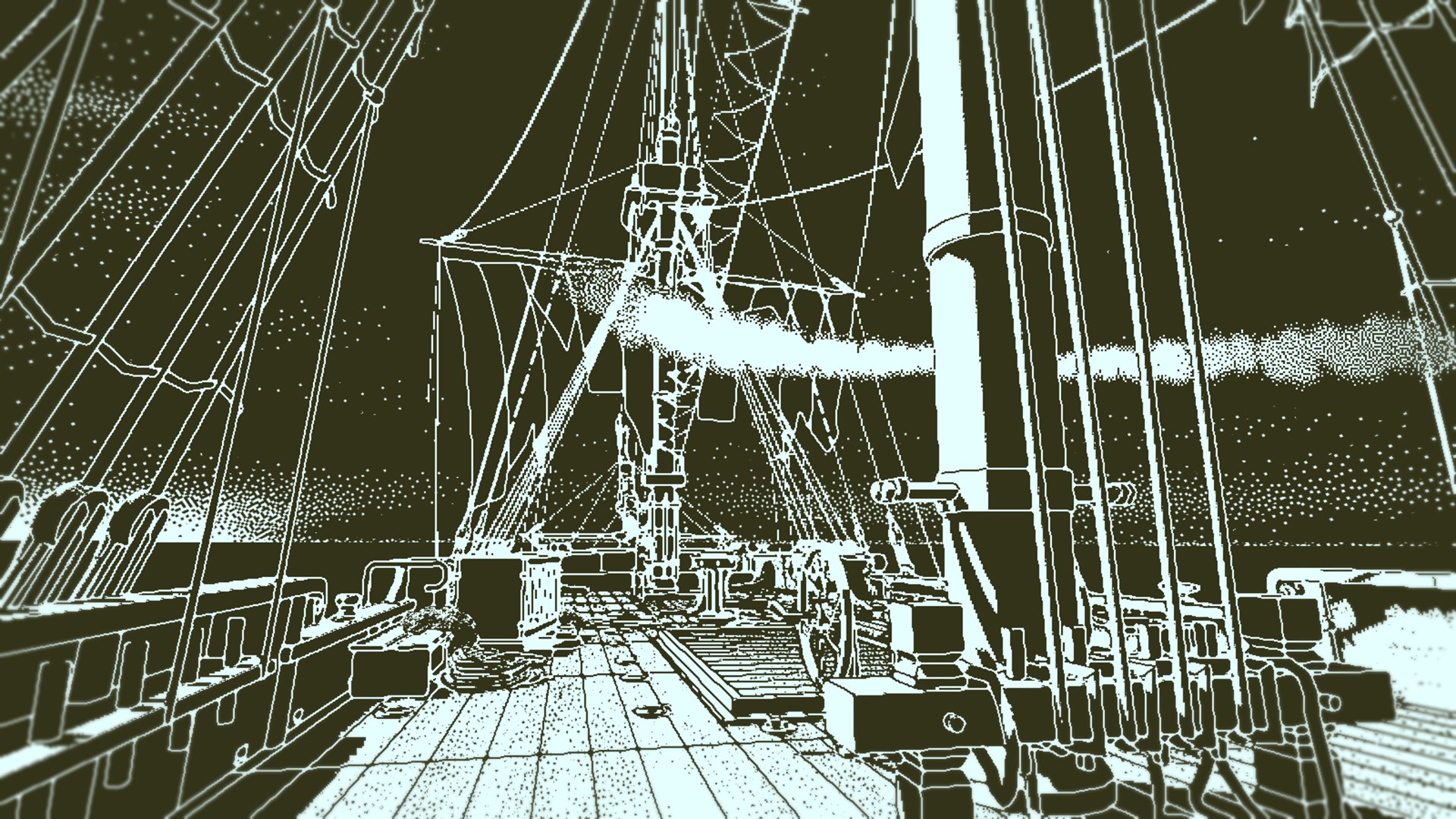
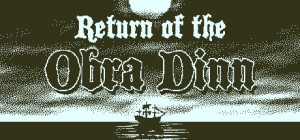 Return of the Obra Dinn was developed by Lucas Pope
Return of the Obra Dinn was developed by Lucas Pope

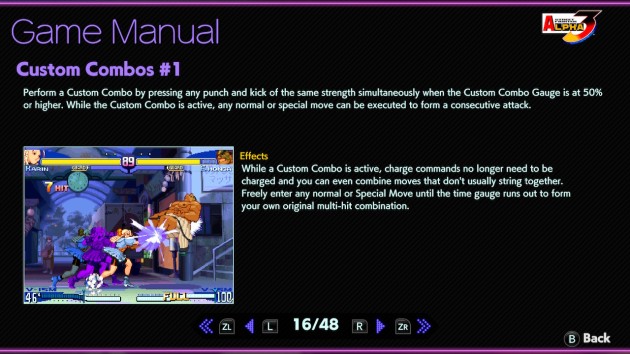
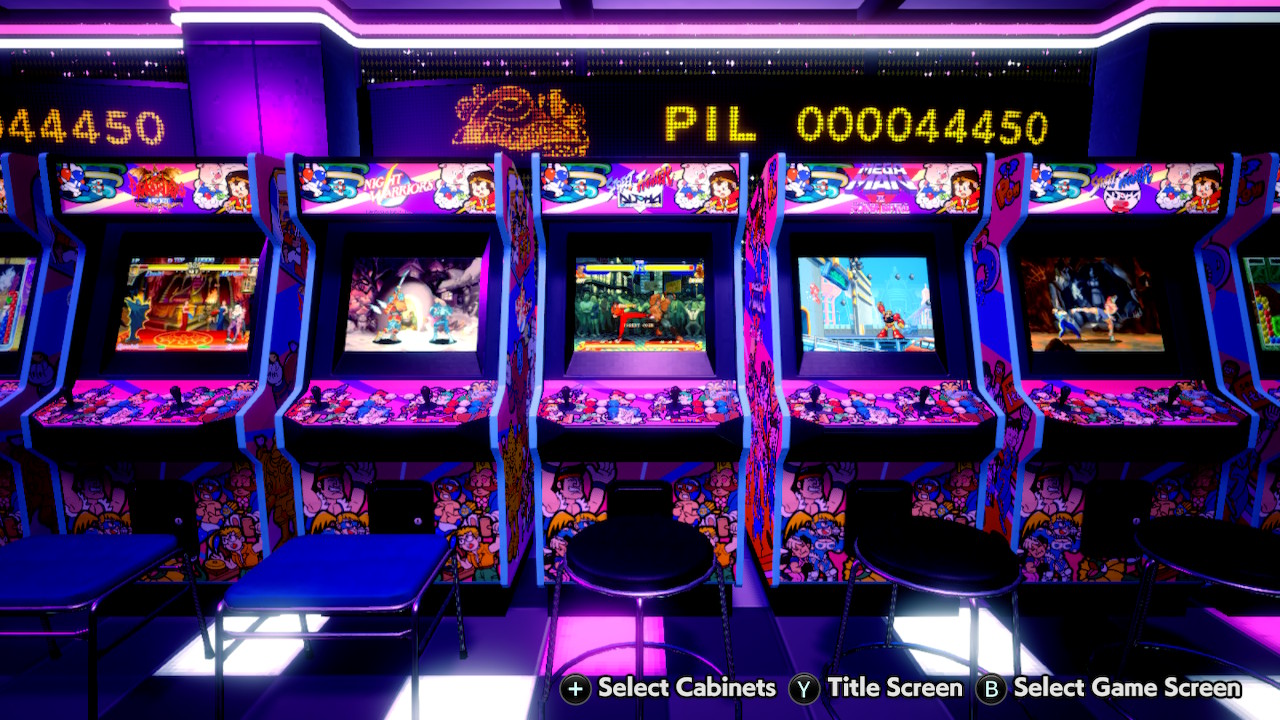
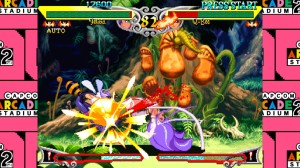 Vampire Savior: The Lord of Vampire
Vampire Savior: The Lord of Vampire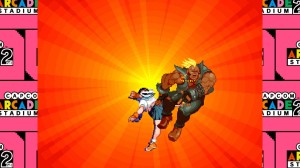 Darkstalkers: The Night Warriors
Darkstalkers: The Night Warriors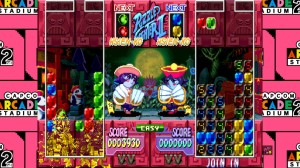 Street Fighter Alpha: Warriors’ Dreams
Street Fighter Alpha: Warriors’ Dreams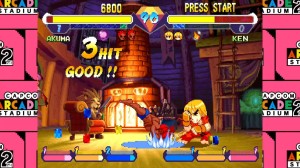 Capcom Sports Club
Capcom Sports Club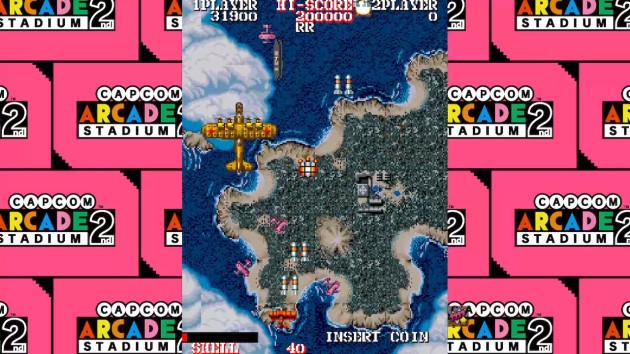
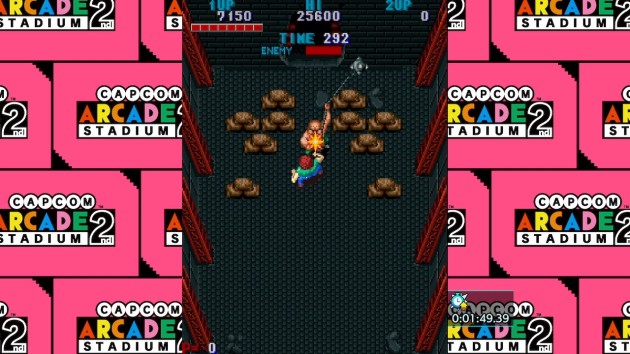
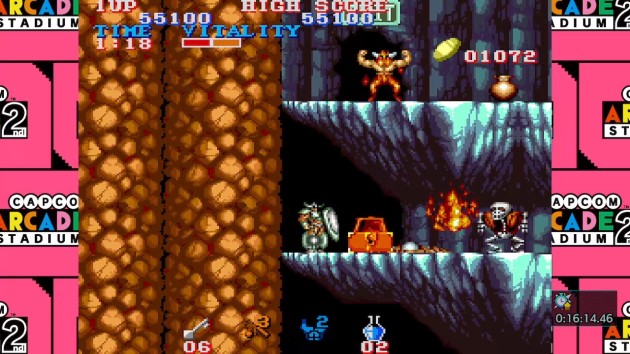
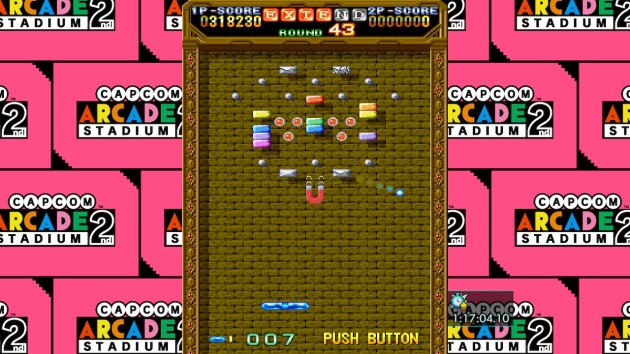

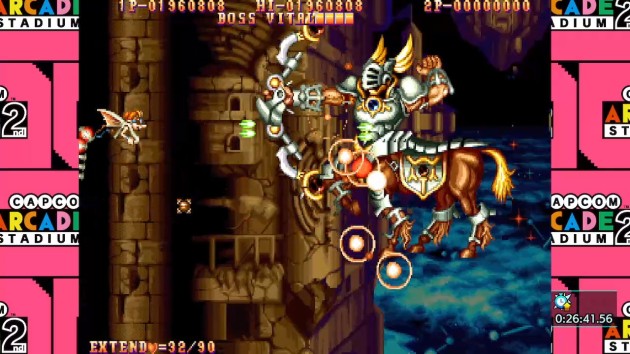

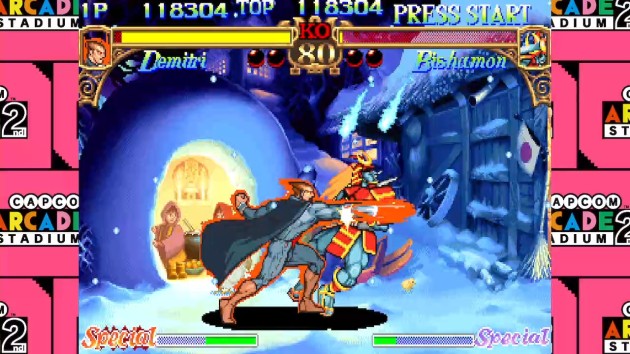
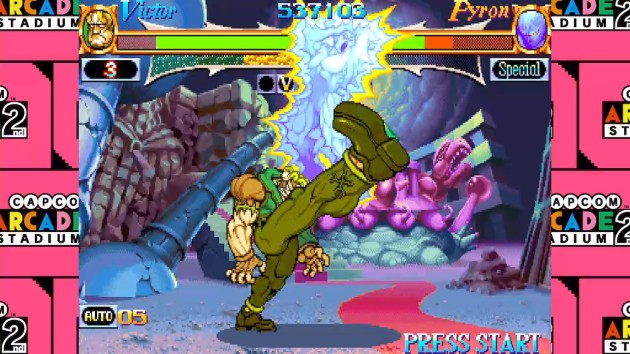
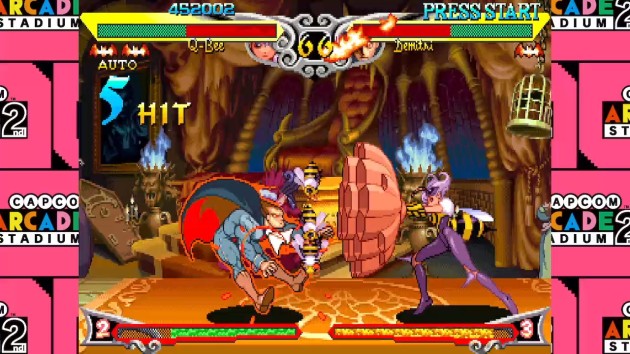
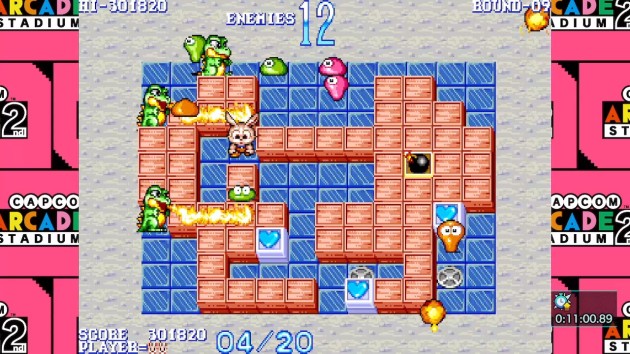
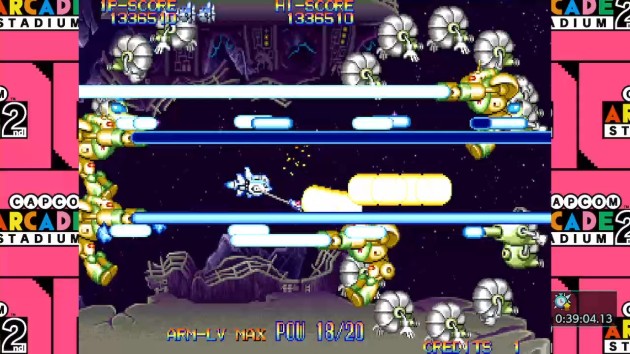
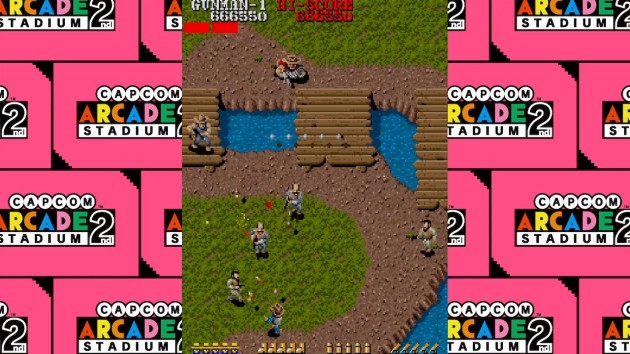
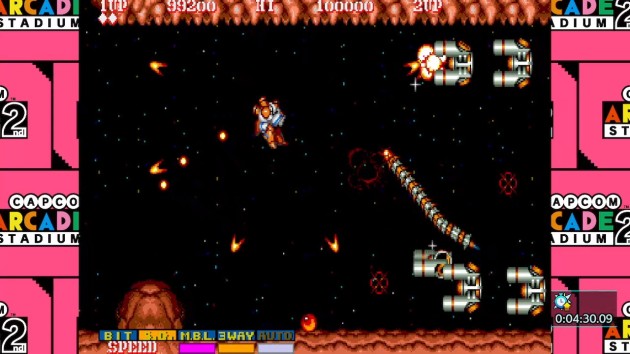
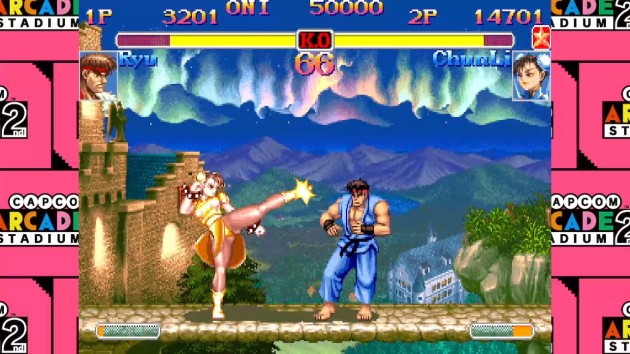
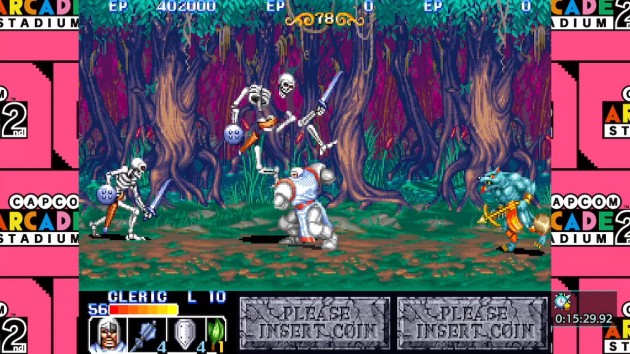
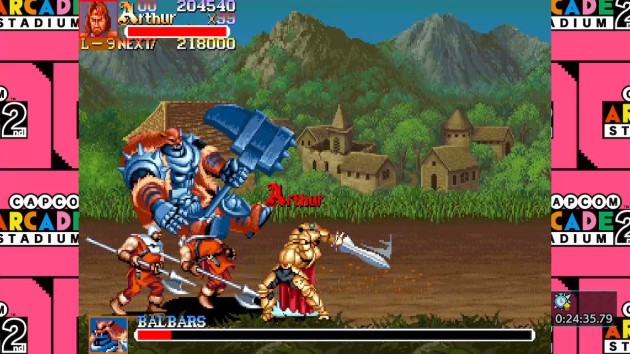
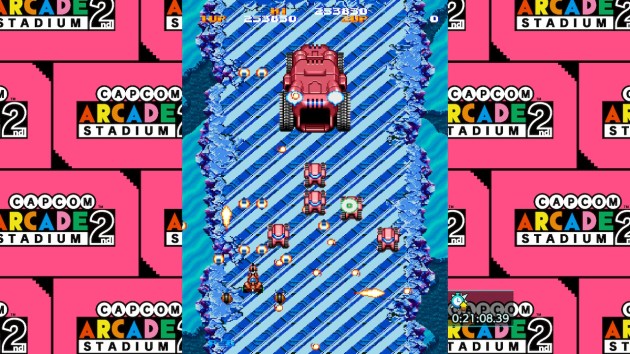
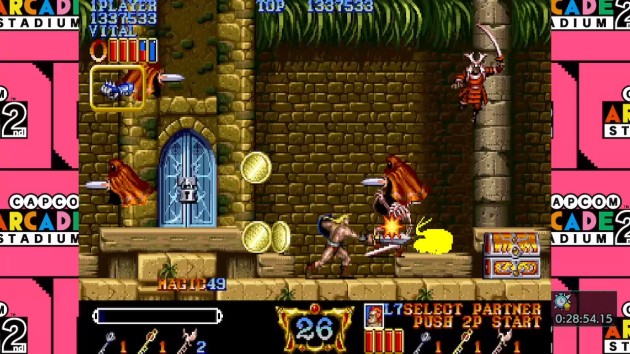
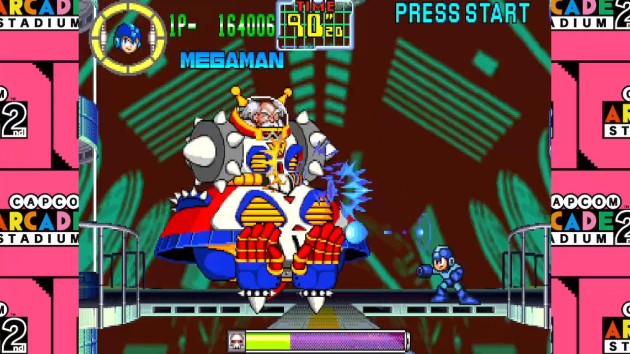
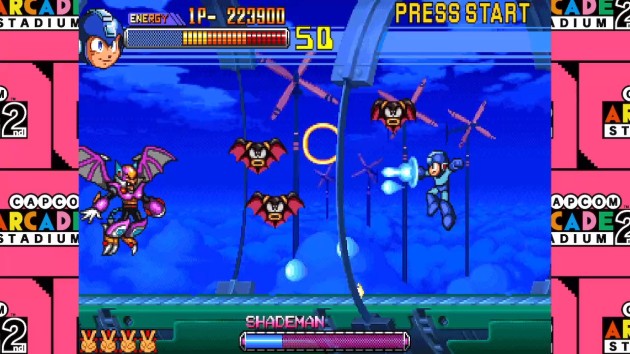
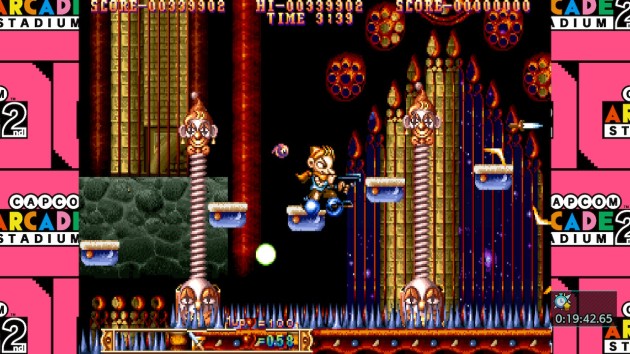
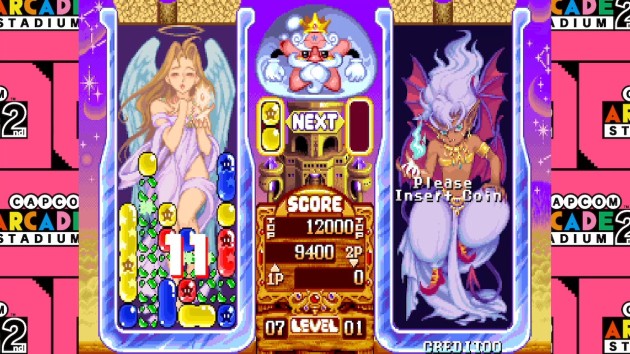
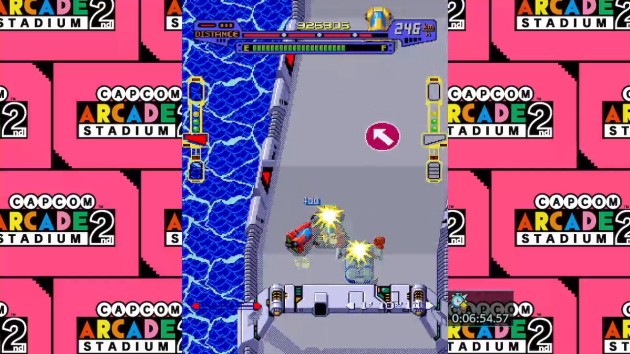
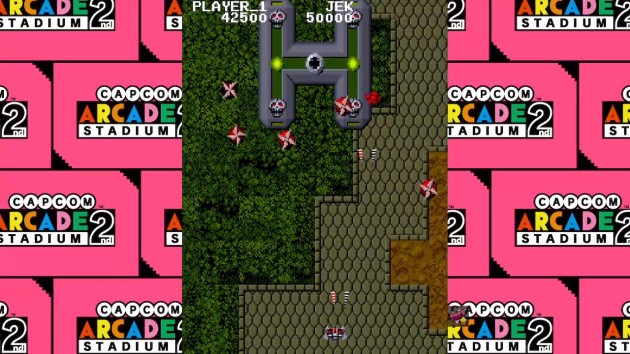
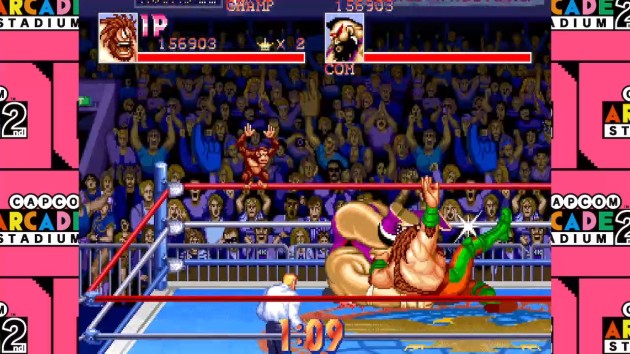
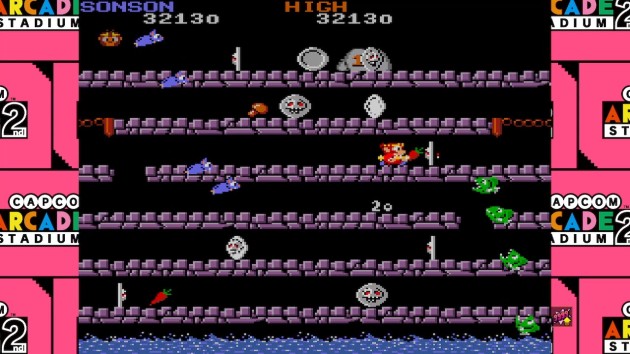
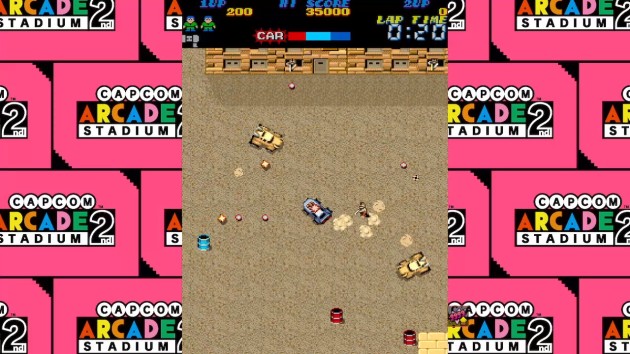
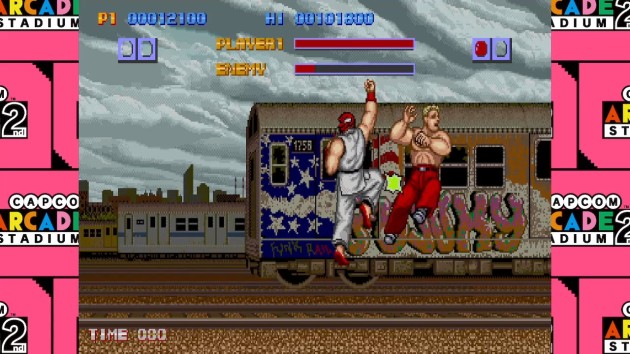
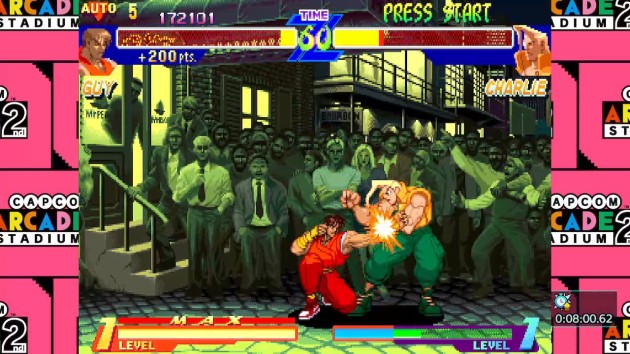
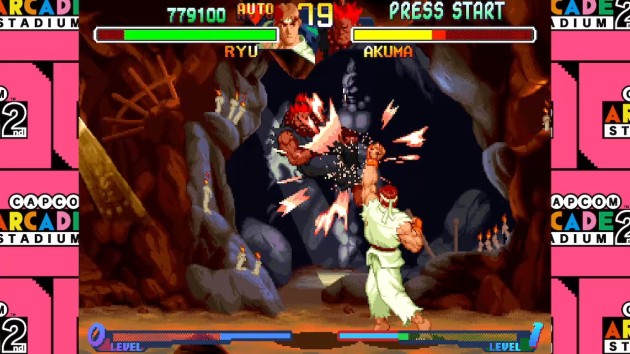
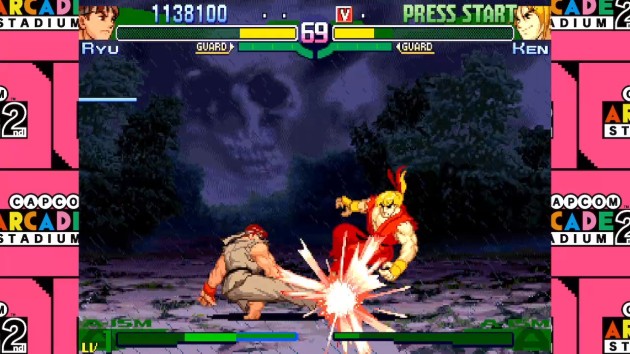
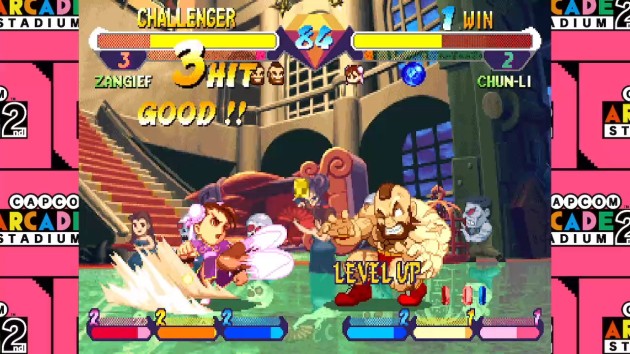
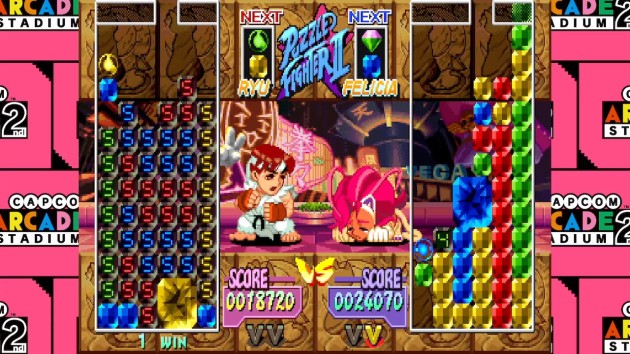
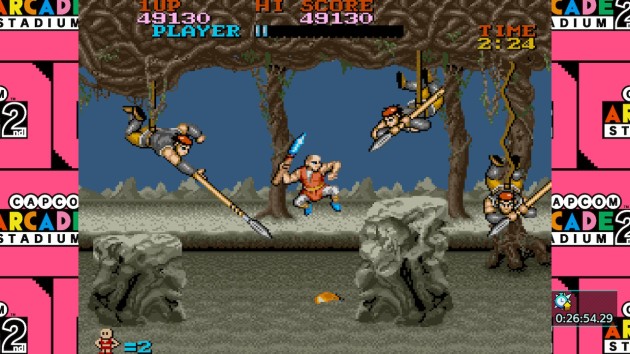
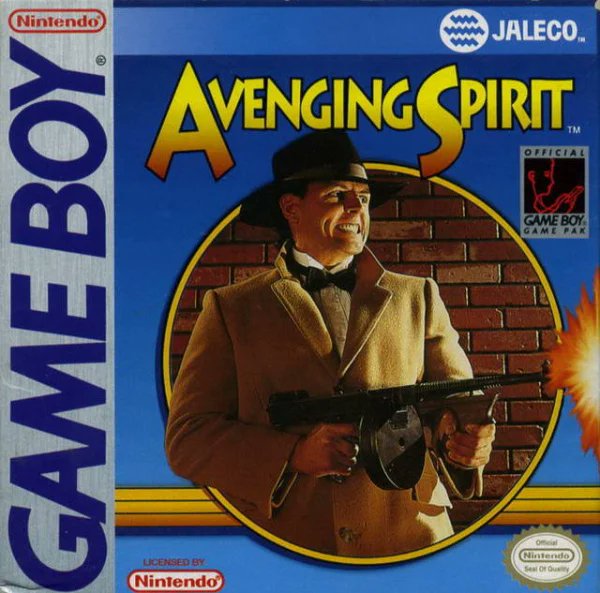

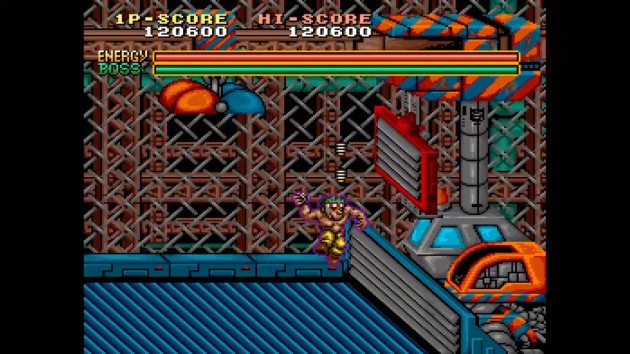
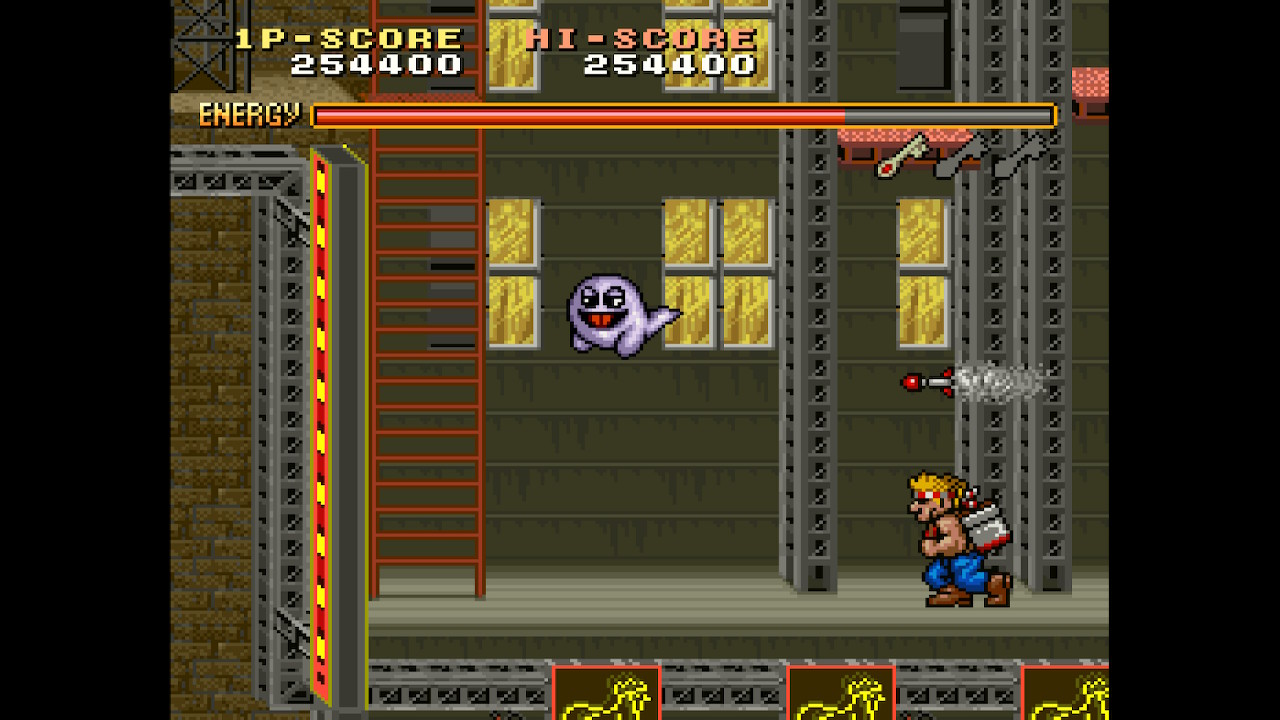
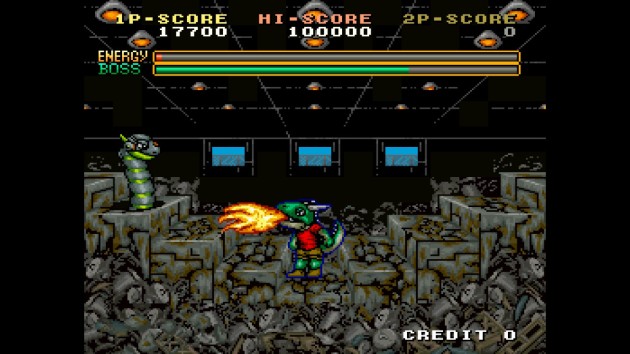

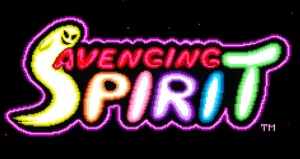
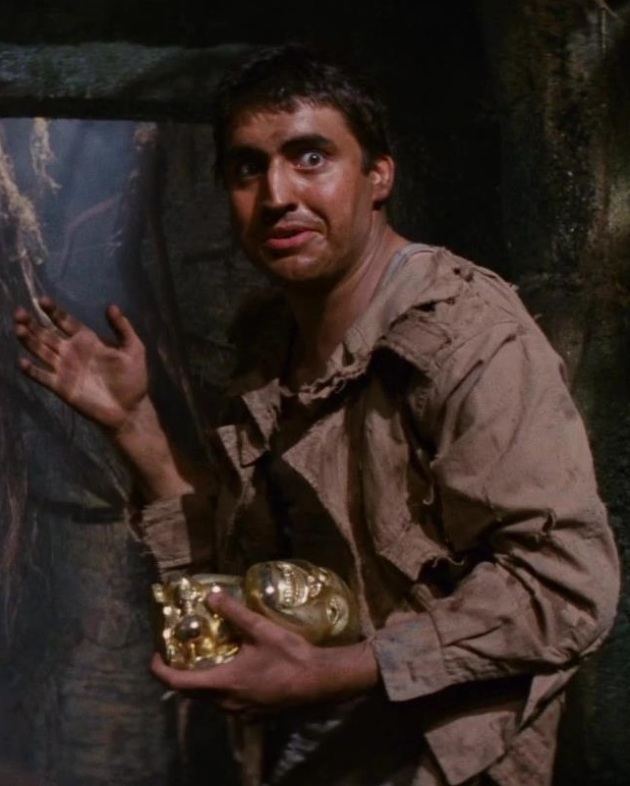

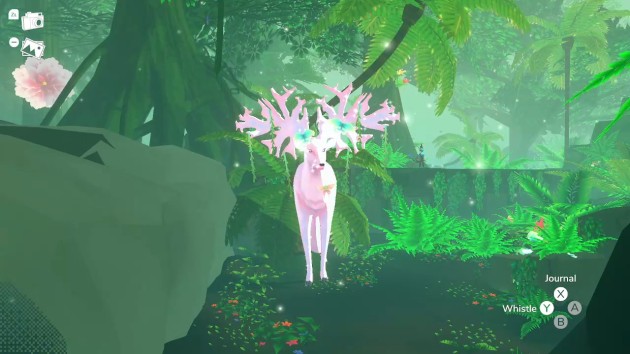
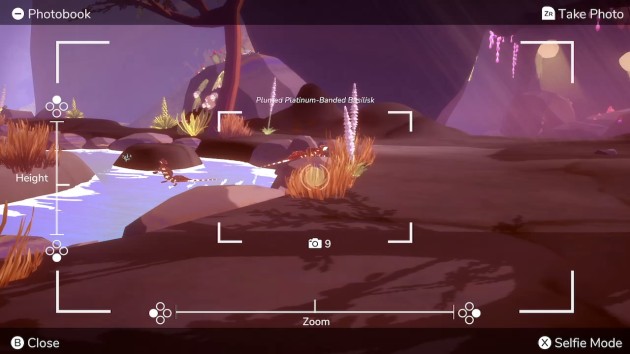
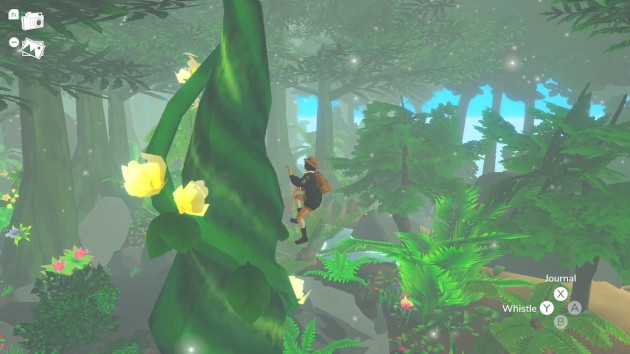
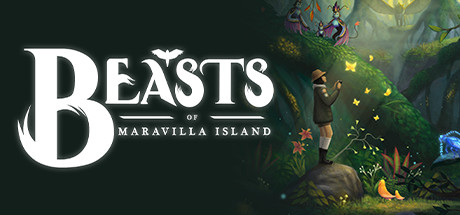 Beasts of Maravilla Island was developed by Banana Bird Studios
Beasts of Maravilla Island was developed by Banana Bird Studios
You must be logged in to post a comment.